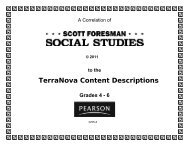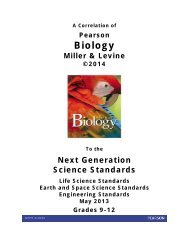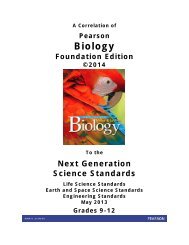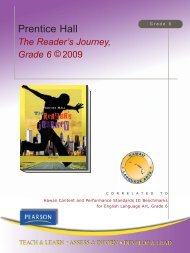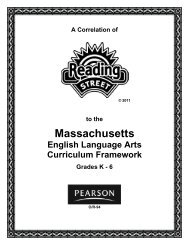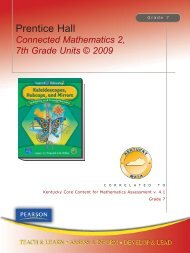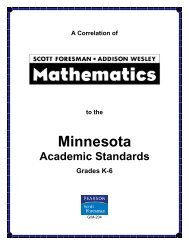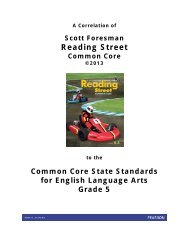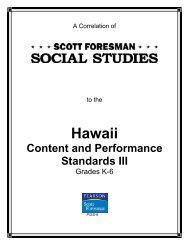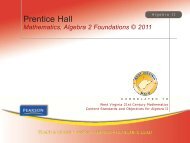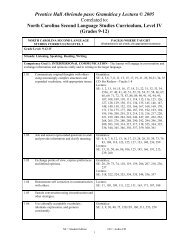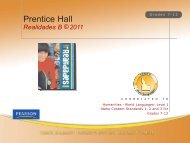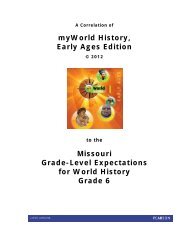Scott Foresman Reading Street Common Core - Pearson
Scott Foresman Reading Street Common Core - Pearson
Scott Foresman Reading Street Common Core - Pearson
Create successful ePaper yourself
Turn your PDF publications into a flip-book with our unique Google optimized e-Paper software.
A Correlation of<strong>Scott</strong> <strong>Foresman</strong><strong>Reading</strong> <strong>Street</strong><strong>Common</strong> <strong>Core</strong>©2013to the<strong>Common</strong> <strong>Core</strong> State Standardsfor English Language ArtsGrade 2
<strong>Scott</strong> <strong>Foresman</strong> <strong>Reading</strong> <strong>Street</strong> <strong>Common</strong> <strong>Core</strong>, ©2013to the<strong>Common</strong> <strong>Core</strong> State Standards for English Language ArtsGrade 2INTRODUCTIONThis document demonstrates how <strong>Scott</strong> <strong>Foresman</strong> <strong>Reading</strong> <strong>Street</strong> <strong>Common</strong> <strong>Core</strong>, ©2013 meetsthe <strong>Common</strong> <strong>Core</strong> State Standards for English Language Arts. Correlation page references are to theTeacher’s Edition and are cited by grade, unit and page references. Lessons in the annotatedTeacher’s Edition contain facsimile Student Edition and ancillary pages. Writing to Sources, acomponent of <strong>Reading</strong> <strong>Street</strong>, is also cited in this correlation by unit and page number.Teaching <strong>Scott</strong> <strong>Foresman</strong> <strong>Reading</strong> <strong>Street</strong>, <strong>Common</strong> <strong>Core</strong> is teaching the <strong>Common</strong> <strong>Core</strong>. <strong>Reading</strong><strong>Street</strong> is built to help teachers easily implement the <strong>Common</strong> <strong>Core</strong> State Standards through rigor andrelevance, text complexity, persuasive and informational writing, and personalized learning. A focuson concepts, language, and content area knowledge ensures that students are building that deep,transferable knowledge necessary for comprehension, and ultimately, college and career readiness.<strong>Scott</strong> <strong>Foresman</strong> <strong>Reading</strong> <strong>Street</strong>, <strong>Common</strong> <strong>Core</strong> is a comprehensive reading program forKindergarten through Grade Six that is built on solid research and prioritizes instruction for the fivecore areas of reading instruction for every grade: Phonemic Awareness, Phonics, Fluency, Vocabularyand Text-Based Comprehension. The foundation of the program was built by an authorship teamcomprised of nationally-renowned authors who have also been leaders in the creation and review ofthe <strong>Common</strong> <strong>Core</strong> State Standards. These authors include Karen Wixson, Peter Afflerbach, and P.David <strong>Pearson</strong>.At the heart of <strong>Reading</strong> <strong>Street</strong>—and the <strong>Common</strong> <strong>Core</strong> State Standards--is the goal of all students tobe able to comprehend on-level text independently. Among the instruction to aid in this goal is theRead for Understanding Routine, which guides students through the main selection following a Close<strong>Reading</strong> routine to develop higher-order thinking skills. The <strong>Reading</strong> <strong>Street</strong> Sleuth encouragesstudents to read like a detective and to use textual evidence as clues to make their case and prove itthrough performance tasks.Writing on <strong>Reading</strong> <strong>Street</strong>Writing instruction on <strong>Reading</strong> <strong>Street</strong> emphasizes the reciprocal nature of reading and writing.Writing instruction integrates the skills and knowledge that students learn and practice as they readand helps students apply those skills and that knowledge in their writing.Differentiated Instruction for Small Group Time<strong>Reading</strong> <strong>Street</strong> instruction is systematic, explicit, and highly focused for all ability levels. Weeklyplans and daily lessons provide small group instruction for Strategic Intervention (below level), On-Level, Advanced, and English Language Learners. <strong>Reading</strong> <strong>Street</strong> follows the Response toIntervention model (RTI) to meet the instructional needs of all students. It offers a process thatmonitors student’s progress throughout the year so teachers can support on-level and advancedstudents and identify struggling readers early.ELL InstructionDaily support for English language learners can be found throughout the <strong>Reading</strong> <strong>Street</strong> Teacher’sEdition. ELL and ELD Readers reinforce the weekly concept and vocabulary while building languageand fluency.21st Century SkillsTechnology on <strong>Scott</strong> <strong>Foresman</strong> <strong>Reading</strong> <strong>Street</strong> can be used both for enhancing student experiencesand preparing them for the future. Throughout the year, research-based technology options enrichinstruction and assist in the management of classroom learning.Key: SE=Student Edition; TE=Teacher’s Edition; EI=Envision It! 2SG=Small Group, UR=Unit Review, WP=Writing Process
<strong>Scott</strong> <strong>Foresman</strong> <strong>Reading</strong> <strong>Street</strong> <strong>Common</strong> <strong>Core</strong>, ©2013to the<strong>Common</strong> <strong>Core</strong> State Standards for English Language ArtsGrade 2Table of Contents<strong>Reading</strong> Standards for Literature ........................................................................... 4<strong>Reading</strong> Standards for Informational Texts.......................................................... 12<strong>Reading</strong> Standards for Foundational Skills ........................................................... 18Writing Standards ................................................................................................ 26Speaking and Listening Standards ....................................................................... 32Language Standards............................................................................................. 36Key: SE=Student Edition; TE=Teacher’s Edition; EI=Envision It! 3SG=Small Group, UR=Unit Review, WP=Writing Process
<strong>Scott</strong> <strong>Foresman</strong> <strong>Reading</strong> <strong>Street</strong> <strong>Common</strong> <strong>Core</strong>, ©2013to the<strong>Common</strong> <strong>Core</strong> State Standards for English Language ArtsGrade 2<strong>Common</strong> <strong>Core</strong> State Standardsfor English Language ArtsKey Ideas and DetailsLiterature 1. Ask and answer suchquestions as who, what, where, when, why,and how to demonstrate understanding ofkey details in a text.<strong>Reading</strong> Standards for Literature<strong>Scott</strong> <strong>Foresman</strong> <strong>Reading</strong> <strong>Street</strong><strong>Common</strong> <strong>Core</strong> Edition, ©2013SE 1: EI•23, 44, 104, 170–171, 174, 245,302, 307, 308–309, 310–311, 336, 372,377, 378–379, 406, 411, 412–413, 414–415, 444, 470, 475, 476–477SE 2: 42, 88, 144, 178, 227, 248, 253,261, 348, 370–371, 372–373, 375 376–377, 378–379, 381, 382, 430–431, 448,520TE 1: 43a, 44–45a, 48–49a, SG•3, SG•4,SG•8, SG•15, 104–105, SG•37, SG•38,SG•51, 155a, 174–175a, SG•71, SG•72,SG•76, SG•77, SG•83, SG•84, UR•51,UR•52–UR•53TE 2: 191a–191b, 192g, 192–193, 194–195, 196–197, 198–199, 200–201, 202–203, 204–205, 206–207, 207a, 208h, 208–209a, 217b, 217c, 244h, 244–245a, 283a–283b, 284g, 284–285, 286–287, 288–289,290–291, 292–293, 294–295, 296–297,298–299, 300–301a, 302–303a, 306–307a,308–309, 313b, 313c, SG•54, SG•55,SG•59, SG•60, SG•61, SG•66, SG•67,319a, 320g–320h, 320–321, 322–323,324–325, 326–327, 328–329, 330–331,332–333, 334–335, 336–337a, 340–341,342–343, 345b, SG•71, SG•72, SG•76,SG•77, SG•78, SG•83, UR•11, UR•41,UR•42–UR•43Key: SE=Student Edition; TE=Teacher’s Edition; EI=Envision It! 4SG=Small Group, UR=Unit Review, WP=Writing Process
<strong>Scott</strong> <strong>Foresman</strong> <strong>Reading</strong> <strong>Street</strong> <strong>Common</strong> <strong>Core</strong>, ©2013to the<strong>Common</strong> <strong>Core</strong> State Standards for English Language ArtsGrade 2<strong>Common</strong> <strong>Core</strong> State Standards<strong>Scott</strong> <strong>Foresman</strong> <strong>Reading</strong> <strong>Street</strong>for English Language Arts <strong>Common</strong> <strong>Core</strong> Edition, ©2013(Continued)Literature 1. Ask and answer suchquestions as who, what, where, when, why,and how to demonstrate understanding ofkey details in a text.(Continued)TE 3: 353a–353b, 354g, 354–355, 356–357, 358–359, 360–361, 362–363, 364–365, 366–367, 368–369, 371a, 372–373a,SG•3, SG•4, SG•5, SG•8, SG•9, SG•15,387a–387b, 388g, 388–389, 390–391,392–393, 394–395, 396–397, 398–399,400–401, 402–403, 404–405a, 406h, 406–407, 410–411, 412–413, 414–415a, 417b,SG•20, SG•21, SG•25, SG•26, SG•32,423a, 424–425, 426–427, 428–429, 430–431, 432–433, 434–435, 436–437, 438–439, 443a, 444h, 444–445a, 448–449a,SG•37, SG•38, SG•42, SG•43, SG•48,SG•49, 458–459, 460–461, 466–467, 468–469, 470–471a, 474h, 474–475, 476–477,SG•54, SG•55, SG•56, SG•59, SG•60,SG•66, SG•70, UR•12, UR•21, UR•22–UR•23TE 4: 27a, 32–33, 34–35, 36–37, 38–39,42h, 42–43a, 46–47, 48–49, 50–51, 51a,SG•3, SG•4, SG•8, SG•9, SG•10, SG•15,80–81a, 124a, 127a, 128–129, 130–131,136–137, 138–139, 144–145a, 153b–153c,SG•54, SG•55, SG•56, SG•57, SG•59,SG•60, SG•61, SG•57, 161a, 177a, 178–179a, SG•71, SG•76, SG•77, SG•78,SG•81, UR•11, UR•12–UR•13TE 5: 216–217, 218–219, 226a, 230–231,232–233, 234–235, 236–237, 238–239,240–241, 242–243, 244–245, 246–247a,247b, 248h, 248–249a, 252–253a, 255b,255g, SG•20, SG•21, SG•22, SG•25,SG•26, SG•31, SG•32, 260a, 263a–264a,264–265, 266–267, 268–269, 270–271,272–273, 274–275, 276–277, 277a, 278–279a, SG•37, SG•38, SG•43, SG•44,SG•49, 295a, 313a, 313b, 314–315a, 318–319, 320–321, SG•54, SG•55, SG•56,SG•59, SG•60, SG•66, 331a, 336–337,338–339, 344–345, 346–347, 347a, 348–349a, 357b, SG•71, SG•72, SG•73, SG•76,SG•77, UR•12, UR•22, UR•32Key: SE=Student Edition; TE=Teacher’s Edition; EI=Envision It! 5SG=Small Group, UR=Unit Review, WP=Writing Process
<strong>Scott</strong> <strong>Foresman</strong> <strong>Reading</strong> <strong>Street</strong> <strong>Common</strong> <strong>Core</strong>, ©2013to the<strong>Common</strong> <strong>Core</strong> State Standards for English Language ArtsGrade 2<strong>Common</strong> <strong>Core</strong> State Standards<strong>Scott</strong> <strong>Foresman</strong> <strong>Reading</strong> <strong>Street</strong>for English Language Arts <strong>Common</strong> <strong>Core</strong> Edition, ©2013(Continued)Literature 1. Ask and answer suchquestions as who, what, where, when, why,and how to demonstrate understanding ofkey details in a text.(Continued)TE 6: 367a, 368–369, 370–371, 372–373,374–375, 376–377, 378–379, 380–381,381a, 381b, 382–383a, SG•3, SG•4, SG•8,SG•9, SG•15, 430a, 433a, 434–435, 436–437, 438–439, 440–441, 442–443, 444–445, 446–447, 447a, 448–449a, 457b,457c, SG•37, SG•38, SG•42, SG•43,SG•49, SG•54, SG•55, SG•56, SG•59,SG•60, SG•66, 500a, 503a, 504–505, 506–507, 508–509, 510–511, 520–521a, 529b,529c, SG•71, SG•72, SG•76, SG•77,UR•32, UR•52Writing to Sources:Unit 1: 26–27, 30–33, 34–35, 36–37Unit 2: 58–59, 60–61, 62–65, 66–67Unit 3: 90–91, 92–93, 94–97, 98–99Unit 5: 154–155, 156–157, 158–161, 162–163Unit 6: 186–187, 188–189, 190–193, 194–195Key: SE=Student Edition; TE=Teacher’s Edition; EI=Envision It! 6SG=Small Group, UR=Unit Review, WP=Writing Process
<strong>Scott</strong> <strong>Foresman</strong> <strong>Reading</strong> <strong>Street</strong> <strong>Common</strong> <strong>Core</strong>, ©2013to the<strong>Common</strong> <strong>Core</strong> State Standards for English Language ArtsGrade 2<strong>Common</strong> <strong>Core</strong> State Standards<strong>Scott</strong> <strong>Foresman</strong> <strong>Reading</strong> <strong>Street</strong>for English Language Arts <strong>Common</strong> <strong>Core</strong> Edition, ©2013Literature 2. Recount stories, includingfables and folktales from diverse cultures,and determine their central message,lesson, or moral.SE 1: 44, 311, 336, 342–343, 372, 444,474SE 2: 42, 124–125, 158–159, 178TE 1: 44–45, SG•48, SG•82TE 2: 301a, 306–307, 308–309, 310–311a,SG•65, 319a–319b, 332–333, 334–335,336–337a, 340–341, 342–343, SG•82,SG•84, UR•51, UR•52–UR•53TE 3: 372h, 373a, 407a, 424g–424h, 430–431, 440–441, 444–445a, 448a–448b,449f, SG•38, 471a, 476–477, 479c, SG•55,UR•31, UR•32–UR•33TE 4: 27a–28a, 28–29, 30–31, 40–41, 41a,41b, 42–43a, 53c, SG•4, SG•12, SG•15,124a, 140–141, 142–143, 143a, 144–145a,144h, 153b, 153c, SG•65, SG•66, 158a,177a, 178h, 178–179a, 187b, SG•72,SG•82, UR•12–UR•13, UR•42–UR•43,UR•52–UR•53TE 5: 247a, 298–299, 314h, 314–315a,348–349aTE 6: 449a, SG•43, SG•65, 519a, 520–521Writing to Sources:Unit 2: 52–53, 56–57Unit 4: 104–105, 114–115Key: SE=Student Edition; TE=Teacher’s Edition; EI=Envision It! 7SG=Small Group, UR=Unit Review, WP=Writing Process
<strong>Scott</strong> <strong>Foresman</strong> <strong>Reading</strong> <strong>Street</strong> <strong>Common</strong> <strong>Core</strong>, ©2013to the<strong>Common</strong> <strong>Core</strong> State Standards for English Language ArtsGrade 2<strong>Common</strong> <strong>Core</strong> State Standards<strong>Scott</strong> <strong>Foresman</strong> <strong>Reading</strong> <strong>Street</strong>for English Language Arts <strong>Common</strong> <strong>Core</strong> Edition, ©2013Literature 3. Describe how characters in astory respond to major events andchallenges.SE 1: EI•14–EI•15SE 2: 37, 41, 42, 248, 292, 314TE 1: 25a–25b, 26g–26h, 26–27, 28–29,30–31, 32–33, 34–35, 36–37, 38–39, 40–41, 42–43, 43a, 51b, SG•15, 72b, 87a–87b, 113b, 113h–113i, 170–171, UR•11,UR•31TE 2: 200–201, 202–203, SG•55, SG•59,SG•60, SG•61, 302h, 322–323, SG•72TE 3: 358–359, 360–361, 362–363, 364–365, 368–369, SG•15, SG•32, 451c,SG•48, 458g–458h, UR•11, UR•31TE 4: 30–31, 32–33, 34–35, 36–37, 38–39,40–41, 46–47, 48–49, 50–51, 51a, SG•4,SG•12, SG•15, 132–133, 134–135, 166–167, 168–169TE 5: 242–243, 244–245, 248–249, SG•21,272–273, 274–275, SG•43, SG•44, SG•49,292a, 296–297, 298–299, 300–301, 302–303, 304–305, 306–307, 308–309, 310–311, 313a, 323b, SG•60, SG•66, 340–341,342–343, 344–345, 346–347, 348h,SG•82, SG•83, UR•42TE 6: 381a, SG•4, SG•15, SG•48, 508–509, 512–513, 529c, SG•77Writing to Sources:Unit 2: 50–51Unit 3: 78–79, 84–85, 98–99Unit 4: 102–103, 118–119Unit 5: 138–139, 142–143, 150–151, 158–161Unit 6: 182–183Key: SE=Student Edition; TE=Teacher’s Edition; EI=Envision It! 8SG=Small Group, UR=Unit Review, WP=Writing Process
<strong>Scott</strong> <strong>Foresman</strong> <strong>Reading</strong> <strong>Street</strong> <strong>Common</strong> <strong>Core</strong>, ©2013to the<strong>Common</strong> <strong>Core</strong> State Standards for English Language ArtsGrade 2<strong>Common</strong> <strong>Core</strong> State Standards<strong>Scott</strong> <strong>Foresman</strong> <strong>Reading</strong> <strong>Street</strong>for English Language Arts <strong>Common</strong> <strong>Core</strong> Edition, ©2013Craft and StructureLiterature 4. Describe how words andphrases (e.g., regular beats, alliteration,rhymes, repeated lines) supply rhythm andmeaning in a story, poem, or song.SE 1: 48–49, 244–245, 311, 448–449SE 2: 80–81, 252–253, 422–423TE 1: 48h, 48–49a, 51cTE 2: 244–245a, 286–287, 311a,SG•66, 345cTE 3: 371b, 448h, 446–447, 448–449aTE 4: 80h, 80–81a, 83c, 136–137TE 5: 252h, 255cTE 6: 374–375, 397c–397d, 422h, 423a,440–441, SG•54, SG•60Writing to Sources:Unit 1: 8–9Unit 2: 54–55Unit 6: 172–173Literature 5. Describe the overall structureof a story, including describing how thebeginning introduces the story and theending concludes the action.SE 1: 104, 302SE 2: 124–125, 158–159, 260–261TE 1: 26g–26h, 26–27, 28–29, 42–43, 43b,44h, 88g–88h, 90–91, 92–93, 94–95, 96–97, 98–99, 100–101, 103a, 104h, 113h–113i, 156g–156h, 158–159, 160–161, 162–163, 173b, 174h, UR•31, UR•32–UR•33TE 2: 294–295, 298–299, 302–303, 306h,SG•55, 340h, UR•41, UR•43TE 3: SG•14, 407a, 417c, SG•31, SG•48,457a, 464–465, 468–469, 479b, SG•65,UR•31, UR•32–UR•33, UR•41, UR•42–UR•43TE 4: 46h, 124a, 140–141, 142–143, 143a,SG•65, 158a, 168–169, 172–173, 174–175, 187b, 187c, SG•82TE 5: 227c, 260a, 268–269, 272–273,277a, 278h, 278–279, 287b, 293c–293d,304–305, 312–313, 313a, 321c–321d,352h, UR•42TE 6: 447b, 448–449a, 457c, 495b, SG•82Writing to Sources:Unit 1: 26–27Unit 5: 142–143Key: SE=Student Edition; TE=Teacher’s Edition; EI=Envision It! 9SG=Small Group, UR=Unit Review, WP=Writing Process
<strong>Scott</strong> <strong>Foresman</strong> <strong>Reading</strong> <strong>Street</strong> <strong>Common</strong> <strong>Core</strong>, ©2013to the<strong>Common</strong> <strong>Core</strong> State Standards for English Language ArtsGrade 2<strong>Common</strong> <strong>Core</strong> State Standards<strong>Scott</strong> <strong>Foresman</strong> <strong>Reading</strong> <strong>Street</strong>for English Language Arts <strong>Common</strong> <strong>Core</strong> Edition, ©2013Literature 6. Acknowledge differences inthe points of view of characters, includingby speaking in a different voice for eachcharacter when reading dialogue aloud.SE 1: 183, 312, 450SE 2: 322TE 1: 174f, 181e, 183, 183cTE 2: 301b, 311b, 313a, 313bTE 3: 444f, 449b, 462–463, 464–465,UR•33TE 4: 34–35, 144fTE 5: 221c, 232–233, 268–269, 277a,285a, 295a–296a, 306–307, 314f, 318–319, 320–321, 357c, UR•42TE 6: 529cIntegration of Knowledge and IdeasLiterature 7. Use information gained fromthe illustrations and words in a print ordigital text to demonstrate understandingof its characters, setting, or plot.SE 1: 104, 174SE 2: 124, 248, 278, SG•54, 314, 348,382, 448TE 1: 38–39, 40–41, SG•3, SG•4, SG•8,SG•14, SG•15, 100–101, 102–103, 103a,104–105a, SG•37, SG•49, 156g–156h,156–157, 158–159, 160–161, 162–163,164–165, 166–167, 170–171, 172–173,174, 174h, UR•12–UR•13, UR•32–UR•33,UR•51, UR•52–UR•53TE 2: 200–201, 248, 278, 314, 335a,SG•83TE 3: 362–363, 388–389, 390–391, SG•14,SG•15, 392–393, 394–395, 400–401, 402–403, 410–411, 412–413, 424–425, 426–427, 432–433, 434–435, 470–471, UR•12,UR•32, UR•51, UR•52–UR•53TE 4: SG•3, SG•8, SG•9, 124a, 128–129,130–131, 132–133, 134–135, 144–145a,SG•55, 162–163, 164–165, 178–179a,SG•72, SG•70SG•76, SG•77, UR•32–UR•33, UR•43Key: SE=Student Edition; TE=Teacher’s Edition; EI=Envision It! 10SG=Small Group, UR=Unit Review, WP=Writing Process
<strong>Scott</strong> <strong>Foresman</strong> <strong>Reading</strong> <strong>Street</strong> <strong>Common</strong> <strong>Core</strong>, ©2013to the<strong>Common</strong> <strong>Core</strong> State Standards for English Language ArtsGrade 2<strong>Common</strong> <strong>Core</strong> State Standards<strong>Scott</strong> <strong>Foresman</strong> <strong>Reading</strong> <strong>Street</strong>for English Language Arts <strong>Common</strong> <strong>Core</strong> Edition, ©2013(Continued)Literature 7. Use information gained fromthe illustrations and words in a print ordigital text to demonstrate understandingof its characters, setting, or plot.(Continued)TE 5: 234–235, 236–237, 238–239, 248–249a, 264–265, 266–267, 268–269, 270–271, 278–279a, 292a, 295a, 300–301,302–303, 310–311, 312–313, 313a, 314–315, 323b, SG•65, 332–333, 334–335,342–343, 348–349a, 357b, 357c, UR•22,UR•52–UR•53TE 6: 367a, 380–381, 382–383a, 434–435,438–439, 448–449, 520–521, SG•71,SG•83, UR•52Writing to Sources:Unit 1: 6–7, 14–15Unit 3: 70–71, 74–75, 82–83Unit 5: 138–139, 140–141Unit 6: 182–1838. (Not applicable to literature) Not applicable according to <strong>Common</strong> <strong>Core</strong>State Standards for English Language ArtsLiterature 9. Compare and contrast two ormore versions of the same story (e.g.,Cinderella stories) by different authors orfrom different cultures.SE 1: 49, 79, 444TE 2: 324–325, 334–335, 335a, UR•52–UR•53TE 3: 428–429, 432–433, 442–443, 443a,444–445, 451cRange of <strong>Reading</strong> and Level of Text ComplexityLiterature 10. By the end of the year, SE 1: 26h, 50, 113, 156h, 182read and comprehend literature, includingstories and poetry, in the grades 2–3 text TE 2: 206–207complexity band proficiently, withTE 3: 410h, 424g–424h, 442–443, 458g–scaffolding as needed at the high end of the 458h, 470hrange.TE 4: 27a–28a, 127a–128a,TE 5: 216h, 229a–229bTE 6: 422–423, 423a, 503a–504a, 519a,520h, 520–521Key: SE=Student Edition; TE=Teacher’s Edition; EI=Envision It! 11SG=Small Group, UR=Unit Review, WP=Writing Process
<strong>Scott</strong> <strong>Foresman</strong> <strong>Reading</strong> <strong>Street</strong> <strong>Common</strong> <strong>Core</strong>, ©2013to the<strong>Common</strong> <strong>Core</strong> State Standards for English Language ArtsGrade 2<strong>Common</strong> <strong>Core</strong> State Standards<strong>Scott</strong> <strong>Foresman</strong> <strong>Reading</strong> <strong>Street</strong>for English Language Arts <strong>Common</strong> <strong>Core</strong> Edition, ©2013<strong>Reading</strong> Standards for Informational TextsKey Ideas and DetailsInformational Text 1. Ask and answersuch questions as who, what, where, when,why, and how to demonstrateunderstanding of key details in a text.SE 1: EI•23, 72, 140, 214, 240, 268, 377,378–379, 508SE 2: 24–25, 76–77, 80, 88–89, 110, 116,182–185, 200, 211, 212, 387, 388, 418TE 1: 58–59, 60–61, 62–63, 64–65, 70–71,71a, 72–73, SG•20, SG•25, SG•26, SG•32,132–133, 134–135, 140, 140h, 140–141a,178–179, 180–181, 183b, SG•54, SG•55,SG•59, SG•60, SG•66, SG•78, SG•84TE 2: 212–213, 214–215, SG•3, 224–225,226–227, 228–229, 230–231, 232–233,234–235, 236–237, 238–239, 239a, 240h,254g, SG•20, SG•21, SG•25, SG•26,SG•27, 254–255, 256–257, 258–259, 260–261, 262–263, 264–265, 268h, 268–269a,272–273, 274–275, 277b, 277c, SG•37,SG•38, SG•39, SG•42, SG•43, SG•49,SG•50, SG•63, SG•80, UR•12–UR•13,UR•31, UR•32–UR•33TE 3: 376–377, 378–379, 486g, 486–487,488–489, 490–491, 492–493, 498–499,500–501, 502–503, 504–505, 506–507,507a, 507b, 508–509a, 512h, 517b, 517c,SG•71, SG•72, SG•76, SG•77, SG•83,UR•51, UR•52–UR•53TE 4: 24a, 61a, 62–63, 64–65, 70–71, 72–73, 74–75, 75a, 76h, 76–77a, 83b, SG•20,SG•21, SG•25, SG•27, SG•32, 88a, 91a,92–93, 94–95, 96–97, 98–99, 100–101,102–103, 104–105, 106–107, 108–109,109a, 110h, 110–111a, 114–115, 116–117,119b, 119c, SG•37, SG•38, SG•42, SG•43,SG•49, SG•50, 182–183, 184–185, UR•32–UR•33TE 5: 194a, 194-195, 197a, 198–199, 200–201, 202–203, 204–205, 206–207, 208–209, 210–211, 211a, 212–213a, SG•3,SG•4, SG•5, SG•8, SG•9, SG•15, 282h,282–283, 284–285, 318–319, 320–321,328a, 352–353, 354–355Key: SE=Student Edition; TE=Teacher’s Edition; EI=Envision It! 12SG=Small Group, UR=Unit Review, WP=Writing Process
<strong>Scott</strong> <strong>Foresman</strong> <strong>Reading</strong> <strong>Street</strong> <strong>Common</strong> <strong>Core</strong>, ©2013to the<strong>Common</strong> <strong>Core</strong> State Standards for English Language ArtsGrade 2<strong>Common</strong> <strong>Core</strong> State Standards<strong>Scott</strong> <strong>Foresman</strong> <strong>Reading</strong> <strong>Street</strong>for English Language Arts <strong>Common</strong> <strong>Core</strong> Edition, ©2013(Continued)Informational Text 1. Ask and answersuch questions as who, what, where, when,why, and how to demonstrateunderstanding of key details in a text.(Continued)TE 6: 364a, 386–387, 388–389, 400–401,402–403, 417a, 418h, 418–419a, SG•20,SG•21, SG•22, SG•25, SG•26, SG•32,462a, 465a, 466–467, 468–469, 470–471,472–473, 474–475, 476–477, 478–479,480–481, 482–483, 484–485, 486–487,487a, 488–489a, 492h, 500a–500b, 524–525, 526–527, UR•42Writing to Sources:Unit 1: 26–27, 28–29, 30–33, 34–35Unit 2: 58–59, 60–61, 62–65, 66–67Unit 3: 90–91, 92–93, 94–97, 98–99Unit 4: 122–123, 124–125, 126–129, 130–131Informational Text 2. Identify the maintopic of a multi-paragraph text as well asthe focus of specific paragraphs within thetext.SE 1: 72–73, 76–77, 140–141, 179, 240,268SE 2: 58–59, 76, 116, 212, SG•31, SG•48,321, 328–329, 387, 418, 488, 526TE 1: SG•12, 57a–57b, 58g–58h, 62–63,64–65, 66–67, 68–69, 70–71, 76–77, 81b,81c, SG•31, 119a–119b, 120g, 122–123,124–125, 126–127, 128–129, 130–131,132–133, 136–137, 140–141, 144–145,146–147, 149d, SG•65, UR•21, UR•22–UR•23, UR•41, UR•42–UR•43TE 2: 240–241, 242–243, 269a, 277c,UR•22–UR•23TE 3: 507a, SG•82, UR•21, UR•22–UR•23,UR•41, UR•42–UR•43TE 4: 58a, 75a, 76–77a, SG•29, SG•31,109a, 111a, SG•39, SG•48, SG•50TE 5: 212–213a, SG•14, 318h, 318–319,320–321, 328aTE 6: 399a, 408–409, 414–415, 417b,418–419, 425b, 425c, SG•31, 476–477,488h, 488–489a, UR•26Writing to Sources:Unit 4: 110–111Key: SE=Student Edition; TE=Teacher’s Edition; EI=Envision It! 13SG=Small Group, UR=Unit Review, WP=Writing Process
<strong>Scott</strong> <strong>Foresman</strong> <strong>Reading</strong> <strong>Street</strong> <strong>Common</strong> <strong>Core</strong>, ©2013to the<strong>Common</strong> <strong>Core</strong> State Standards for English Language ArtsGrade 2<strong>Common</strong> <strong>Core</strong> State Standards<strong>Scott</strong> <strong>Foresman</strong> <strong>Reading</strong> <strong>Street</strong>for English Language Arts <strong>Common</strong> <strong>Core</strong> Edition, ©2013Informational Text 3. Describe theconnection between a series of historicalevents, scientific ideas or concepts, or stepsin technical procedures in a text.SE 1: EI•26, 108–109, 110–111SE 2: 58–59, 110, 282–285, 389, 462–463TE 1: 108–109, 110–111, 113cTE 2: 236–237, 238–239TE 3: 490–491, 492–493, 496–497, 507aTE 4: 58a, 83b, SG•22, SG•26, SG•27,SG•32, SG•34, SG•39, 150–151TE 5: 282–283, 284–285, 287cTE 6: 408–409, 410–411, 416–417, 418h,418–419a, 468–469, 472–473, UR•42Writing to Sources:Unit 2: 38–39, 42–43, 46–47Unit 4: 106–107, 108–109, 116–117Unit 5: 134–135Craft and StructureInformational Text 4. Determine themeaning of words and phrases in a textrelevant to a grade 2 topic or subject area.SE 2: 26–27, 60–61, 126–127, 196–197,398–399, 432–433, 464–465TE 1: 54a–54b, 58a–58b, 58f, 72g, 81b,SG•20, SG•29, SG•46, 122–123, 126–127,140g, SG•55, SG•59, SG•63TE 2: 224f, 234–235, 254f, 256–257,SG•38, SG•42, SG•43, SG•46TE 3: 502–503, 508g, SG•77, SG•78,SG•80TE 4: 25a, 59a, 60g, 70–71, SG•21,SG•26, 89a, 96–97, 100–101, SG•38TE 5: 195a, 204–205, 206–207, 212g,221b, SG•4, SG•9TE 6: 397a, 398e, 402–403, 425b, SG•20,SG•26, 463a, 464e, 478–479Writing to Sources:Unit 2: 48–49Unit 5: 134–135Key: SE=Student Edition; TE=Teacher’s Edition; EI=Envision It! 14SG=Small Group, UR=Unit Review, WP=Writing Process
<strong>Scott</strong> <strong>Foresman</strong> <strong>Reading</strong> <strong>Street</strong> <strong>Common</strong> <strong>Core</strong>, ©2013to the<strong>Common</strong> <strong>Core</strong> State Standards for English Language ArtsGrade 2<strong>Common</strong> <strong>Core</strong> State Standards<strong>Scott</strong> <strong>Foresman</strong> <strong>Reading</strong> <strong>Street</strong>for English Language Arts <strong>Common</strong> <strong>Core</strong> Edition, ©2013Informational Text 5. Know and usevarious text features (e.g., captions, boldprint, subheadings, glossaries, indexes,electronic menus, icons) to locate key factsor information in a text efficiently.SE 1: 72, 76, 78–79, 108–109, 144–145,178–179, 212–213, 236–237, 272–273,274–275, 512–513, 514–515SE 2: 114–115, 148–149, 216–217, 318–319, 386, 389, 452–453, 454TE 1: 58–59, 60–61, 66–67, 71b, 72–73,76h, 76–77, 78–79, 81c, SG•25, SG•26,108–109, 136–137, 139f, 144h, 149c, 178hTE 2: 236–237, 253a–253b, 262–263,264–265, 267g, 272h, 272–273, 274–275,301g, 335f, UR•23, UR•31TE 3: 405g, 469f, 512–513, 514–515TE 4: 41g, 61a, 64–65, 68–69, 75a, 109a,114h, 114–115, SG•39, 143fTE 5: 211g, 313g, 318h, 318–319, 352hTE 6: 452h, 452–453, 487g, 492–493a,493fWriting to Sources:Unit 1: 10–11, 12–13, 16–17, 20–21Informational Text 6. Identify the mainpurpose of a text, including what the authorwants to answer, explain, or describe.SE 1: 72, 140, 240, 268, 378, 508SE 2: 76, 110, 144, 178, 320, 321, 328–329, 396–397, 418, 492, 525TE 1: SG•5, SG•10, 72h, 72–73a, 108h,136–137, 139a, 140–141, 144–145149bTE 2: 212h, 223a–223b, 224g, 228–229,240–241, 267b, UR•21, UR•22–UR•23,UR•31TE 3: 353a–353b, 376h, 376–377, 378–379, 381b, 508–509TE 4: 75b, 76–77, 119c, 150–151, 182hTE 5: 212h, 212–213, 282–283, 284–285,320–321, 323c, 352hTE 6: 396a, 402–403, 404–405, 408–409,410–411, 412–413, 418–419, 425b, 425c,487a, 488–489a, 495c, 524h, UR•26Writing to Sources:Unit 4: 110–111Key: SE=Student Edition; TE=Teacher’s Edition; EI=Envision It! 15SG=Small Group, UR=Unit Review, WP=Writing Process
<strong>Scott</strong> <strong>Foresman</strong> <strong>Reading</strong> <strong>Street</strong> <strong>Common</strong> <strong>Core</strong>, ©2013to the<strong>Common</strong> <strong>Core</strong> State Standards for English Language ArtsGrade 2<strong>Common</strong> <strong>Core</strong> State Standards<strong>Scott</strong> <strong>Foresman</strong> <strong>Reading</strong> <strong>Street</strong>for English Language Arts <strong>Common</strong> <strong>Core</strong> Edition, ©2013Integration of Knowledge and IdeasInformational Text 7. Explain howspecific images (e.g., a diagram showinghow a machine works) contribute to andclarify a text.SE 1: 108–109SE 2: 152, 282, 388TE 1: 108–109, 113c, 173gTE 2: 236–237, 239fTE 3: 371g, 486–487TE 4: 68–69, 104–105, 109b, 109g,SG•42, SG•43TE 5: 247g, 287cTE 6: 391c, 412–413, 487b, UR•12Writing to Sources:Unit 6: 180–181Informational Text 8. Describe howreasons support specific points the authormakes in a text.Informational Text 9. Compare andcontrast the most important pointspresented by two texts on the same topic.SE 2: 194TE 2: 223a, 228–229, 230–231, 232–233,234–235, UR•22TE 3: 381b, 490–491, 506–507TE 4: 75b, SG•46TE 6: 388–389, 404–405, 417a, 486–487,487aSE 1: 79, 181, 215, 245, 449SE 2: 81, 117, 185, 219, 285, 389, 493,527TE 1: 78–79TE 2: 245aTE 4: 109aTE 5: 202–203, 211aTE 6: 417a, 487a, 493aWriting to Sources:Unit 1: 12–13, 20–21Unit 2: 40–41, 48–49Unit 3: 88–89Unit 4: 108–109, 112–113, 122–123, 124–125Key: SE=Student Edition; TE=Teacher’s Edition; EI=Envision It! 16SG=Small Group, UR=Unit Review, WP=Writing Process
<strong>Scott</strong> <strong>Foresman</strong> <strong>Reading</strong> <strong>Street</strong> <strong>Common</strong> <strong>Core</strong>, ©2013to the<strong>Common</strong> <strong>Core</strong> State Standards for English Language ArtsGrade 2<strong>Common</strong> <strong>Core</strong> State Standards<strong>Scott</strong> <strong>Foresman</strong> <strong>Reading</strong> <strong>Street</strong>for English Language Arts <strong>Common</strong> <strong>Core</strong> Edition, ©2013Range of <strong>Reading</strong> and Level of Text ComplexityInformational Text 10. By the end ofyear, read and comprehend informationaltexts, including history/social studies,science, and technical texts, in the grades2–3 text complexity band proficiently, withscaffolding as needed at the high end of therange.SE 1: 120–139, 224–239, 254–267, 486–507SE 2: 62–75, 92–110, 466–488TE 2: 224g–224h, 254g–254hTE 3: 486g–486h, 517cTE 4: 61a–62a, 91a–92aTE 5: 197a–198aTE 6: 399a–400a, 465a–466a, 492–493a,524hKey: SE=Student Edition; TE=Teacher’s Edition; EI=Envision It! 17SG=Small Group, UR=Unit Review, WP=Writing Process
<strong>Scott</strong> <strong>Foresman</strong> <strong>Reading</strong> <strong>Street</strong> <strong>Common</strong> <strong>Core</strong>, ©2013to the<strong>Common</strong> <strong>Core</strong> State Standards for English Language ArtsGrade 2<strong>Common</strong> <strong>Core</strong> State Standards<strong>Scott</strong> <strong>Foresman</strong> <strong>Reading</strong> <strong>Street</strong>for English Language Arts <strong>Common</strong> <strong>Core</strong> Edition, ©2013Print ConceptsFoundational Skills 1. (Not applicable toGrade 2)<strong>Reading</strong> Standards for Foundational SkillsNot applicable according to <strong>Common</strong> <strong>Core</strong>State Standards for English Language ArtsPhonological AwarenessFoundational Skills 2. (Not applicable toGrade 2)Phonics and Word RecognitionFoundational Skills 3. Know and applygrade-level phonics and word analysis skillsin decoding words.Not applicable according to <strong>Common</strong> <strong>Core</strong>State Standards for English Language ArtsSE 1: 24–25, 56–57, 86–87, 118–119,190–191, 222–223, 252–253, 282–283,456, 484–485SE 2: 22–23, 56–57, 86–87, 122–123,156–157, 192–193, 224–225, 258–259,290–291, 326–327, 352–353, 362–363,386–387, 394–395, 422–423, 428–429,460–461, 498–499TE 1: 23a, 24–24a, 24b–24c, 26c, 34–35,44c–44d, 48c–48d, 48e–48f, 48g, 50c, 51d,54, SG•2, SG•3, SG•7, SG•8, SG•9,SG•12, SG•14, 54, 55a, 56–56a, 56b–56c,58c, 62–63, 72c–72d, 76c–76d, 76e–76f,80c, 81d, SG•19, SG•20, SG•24, SG•31,85a, 86–86a, 86b–86c, 88c, 92–93, 104c–104d, 104g, 108c–108d, 108e–108f, 112c,113d–113e, SG•36, SG•37, SG•41, SG•46,SG•48, 117a, 118–118a, 118b–118c, 120c,130–131, 140c–140d, 144c, 144e–144f,148c, 149d–149e, SG•53, SG•54, SG•58,SG•59, SG•60, SG•63, SG•65, 153a, 154–154a, 154b–154c, 156c, 166–167, 174c–174d, 178c, 178e–178f, 182c, 183d–183e,SG•70, SG•71, SG•70, SG•75, SG•76,SG•77, SG•80, SG•83, UR•8, UR•18,UR•28, UR•38, UR•48Key: SE=Student Edition; TE=Teacher’s Edition; EI=Envision It! 18SG=Small Group, UR=Unit Review, WP=Writing Process
<strong>Scott</strong> <strong>Foresman</strong> <strong>Reading</strong> <strong>Street</strong> <strong>Common</strong> <strong>Core</strong>, ©2013to the<strong>Common</strong> <strong>Core</strong> State Standards for English Language ArtsGrade 2<strong>Common</strong> <strong>Core</strong> State Standards<strong>Scott</strong> <strong>Foresman</strong> <strong>Reading</strong> <strong>Street</strong>for English Language Arts <strong>Common</strong> <strong>Core</strong> Edition, ©2013(Continued)Foundational Skills 3. Know and applygrade-level phonics and word analysis skillsin decoding words.(Continued)TE 2: 189a, 190–190a, 190b–190c, 192c,198–199, 208c–208d, 212c, 212e–212f,216c, 217d, SG•2, SG•3, SG•7, SG•8,SG•9, SG•12, 221a, 222b–222c, 224c,224e, 226–227, 240c–240d, 244c, 244d,244e–244f, 246c, 247d, SG•19, SG•20,SG•25, SG•26, SG•29, 251a, 252–252a,252b–252c, 254c, 260–261, 268c, 268d,272c, 272d, 272e–272f, 276c, 277d,SG•36, SG•37, SG•42, SG•43, 281a, 282–282a, 282b–282c, 284c, 290–291, 302c–302d, 306c–306d, 306e–306f, 312c, 313d,SG•53, SG•54, SG•58, SG•59, SG•60,SG•63, SG•65, 317a, 318–318a, 318b–318c, 332–333, 336c–336d, 340c–340d,340e–340f, 345d, SG•70, SG•71, SG•76,SG•77, UR•8, UR•28, UR•36TE 3: 352b–352c, 372c–372d, 376e–376f,SG•7, 385a, 386b–386c, 400–401, 406c–406d, 410e–410f, SG•24, 421a, 422b–422c, 424c, 436–437, 444c–444d, 448c–448d, 448e–448f, 451d, SG•36, SG•37,SG•41, SG•42, SG•43, SG•46, SG•48,455a, 456b–456c, 462–463, 470c–470d,474c–474d, 474e–474f, 478c, 483a, 484–484a, 484b–484c, 486c, 494–495, 508c–508d, 512e–512f, 516c, SG•70, SG•71,SG•76, SG•77, SG•80, SG•82, UR•8,UR•18, UR•28, UR•38, UR•48TE 4: 22a–22b, 23a, 23c–23d, 26c, 42c–42d, 46c, 46e–46f, 52c, SG•2, SG•7,SG•12, 57c–57d, 68–69, 76c–76d, 80c–80d, 80e–80f, SG•24, SG•29, 87c–87d,110c–110d, 114e–114f, 118c, SG•36,SG•41, SG•46, 122a, 122–123, 123a,123c–123d, 126c, 144c–144d, 148e–148f,152c, SG•53, SG•58, SG•63, 156a, 156–157, 157c–157d, 160c, 178c–178d, 182c–182d, 182e–182f, SG•70, SG•80, UR•8Key: SE=Student Edition; TE=Teacher’s Edition; EI=Envision It! 19SG=Small Group, UR=Unit Review, WP=Writing Process
<strong>Scott</strong> <strong>Foresman</strong> <strong>Reading</strong> <strong>Street</strong> <strong>Common</strong> <strong>Core</strong>, ©2013to the<strong>Common</strong> <strong>Core</strong> State Standards for English Language ArtsGrade 2<strong>Common</strong> <strong>Core</strong> State Standards<strong>Scott</strong> <strong>Foresman</strong> <strong>Reading</strong> <strong>Street</strong>for English Language Arts <strong>Common</strong> <strong>Core</strong> Edition, ©2013(Continued)Foundational Skills 3. Know and applygrade-level phonics and word analysis skillsin decoding words.(Continued)TE 5: 193c–193d, 204–205, 212c–212d,216e–216f, 225c–225d, 236–237, 248c–248d, 252e–252f, 258a, 258–259, 259a,259c–259d, 262c, 270–271, 278c–278d,282e–282f, 286c, SG•36, SG•41, 290a,290–291, 291a, 291c–291d, 294c, 314c–314d, 318c, 318e–318f, 322c, SG•53,SG•58, SG•63, 326a, 326–327, 327c–327d, 340–341, 348c–348d, 352c–352d,352e–352f, 357d, 357f, SG•70, UR•28,UR•38TE 6: 362a, 362–363, 363a, 363c–363d,366c, 370–371, 382c–382d, 386c, 386e–386f, 390c, 391d, SG•2, SG•7, SG•12,394a, 394–395, 395c–395d, 418c–418d,422c–422d, 422e–422f, 424c, SG•19,SG•24, SG•29, 428a, 428–429, 429a,429c–429d, 432c, 440–441, 448c–448d,452c–452d, 452e–452f, 456c, 457d,SG•36, SG•46, 461c–461d, 474–475,488c–488d, 492c–492d, 492e–492f, 498a,498–499, 499c–499d, 502f, 512–513,520c–520d, 524c–524d, 524e–524f, 529d,UR•8, UR•18, UR•28Foundational Skills 3.a. Distinguish longand short vowels when reading regularlyspelled one-syllable words.SE 1: 24, 54, 56TE 1: 24–24a, 24b–24c, 48g, 50c, 54,SG•9, 55a, 56, 56b–56c, 58c, 58d, 76c–76d, 76e–76f, 80c, SG•24, SG•25, SG•26,SG•29, SG•31, 108d, 108e–108f, UR•8,UR•19, UR•38TE 2: 317a, 320c, 336c–336d, 344c,UR•48TE 3: 351a, 352–352a, 372c–372d, 376c–376d, 380c, SG•2, SG•7, SG•8, SG•9,SG•12, 410c–410d, 416c, SG•19, SG•20,SG•24, SG•26, SG•29, SG•31, 448c, 448d,456–456a, 458c, 470c–470d, SG•53,SG•54, SG•58, SG•59, SG•60, SG•63,SG•65, 512c, UR•8, UR•18TE 4: 178cKey: SE=Student Edition; TE=Teacher’s Edition; EI=Envision It! 20SG=Small Group, UR=Unit Review, WP=Writing Process
<strong>Scott</strong> <strong>Foresman</strong> <strong>Reading</strong> <strong>Street</strong> <strong>Common</strong> <strong>Core</strong>, ©2013to the<strong>Common</strong> <strong>Core</strong> State Standards for English Language ArtsGrade 2<strong>Common</strong> <strong>Core</strong> State Standards<strong>Scott</strong> <strong>Foresman</strong> <strong>Reading</strong> <strong>Street</strong>for English Language Arts <strong>Common</strong> <strong>Core</strong> Edition, ©2013Foundational Skills 3.b. Know spellingsound correspondences for additionalcommon vowel teams.SE 1: 190, 252, 318, 352, 386, 456SE 2: 56, 86, 156, 326TE 2: 318–318a, 318d, SG•70, SG•75,SG•76, SG•77, SG•82TE 3: 351a, 352–352a, 354c, 372c–372d,376e–376f, 376g, SG•2, SG•3, SG•8,SG•9, 386–386a, 388c, 406c–406d, 416c–416d, SG•19, SG•20, SG•25, 456–456a,458c, 458d, 474e–474f, SG•53, SG•54,SG•59, SG•60, UR•8, UR•9, UR•39TE 4: 56a, 56–57, 57a, 60c, 60d, 76d, 80d,82c, 86a, 86–87, 87a, 90c, 110c–110d,110e, 114c, SG•36, SG•41, SG•46, 123b,148c–148d, 148e–148f, 152d, SG•53,156a, 156–157, 157b, 160c, 160d, 178c–178d, 178e, 186c, 182d, 182e–182f, 182g,186d, SG•75, SG•80, UR•18, UR•19,UR•28, UR•29, UR•48, UR•49TE 5: 216c, 216d, 326a, 326–327, 327a,327b, 330c, 330d, 348c–348d, 352e–352f,352g, 356c, 356d, SG•70, SG•80, UR•48,UR•49TE 6: 386cFoundational Skills 3.c. Decode regularlyspelled two-syllable words with long vowels.SE 1: 56, 318, 386, 456SE 2: 122TE 1: 55a, 56–56a, 58c, 72d, 76d, 80c,SG•19, SG•20, SG•29, SG•31, 108c–108dTE 2: 318–318a, 318d, 320c, 344c, SG•80,SG•82, UR•48TE 3: 351a, 352–352aTE 4: 22a–22b, 23c–23d, 80c, 122a, 122–123, 148e–148f, SG•63, UR•38Key: SE=Student Edition; TE=Teacher’s Edition; EI=Envision It! 21SG=Small Group, UR=Unit Review, WP=Writing Process
<strong>Scott</strong> <strong>Foresman</strong> <strong>Reading</strong> <strong>Street</strong> <strong>Common</strong> <strong>Core</strong>, ©2013to the<strong>Common</strong> <strong>Core</strong> State Standards for English Language ArtsGrade 2<strong>Common</strong> <strong>Core</strong> State Standards<strong>Scott</strong> <strong>Foresman</strong> <strong>Reading</strong> <strong>Street</strong>for English Language Arts <strong>Common</strong> <strong>Core</strong> Edition, ©2013Foundational Skills 3.d. Decode wordswith common prefixes and suffixes.SE 1: 416SE 2: 192–193, 224–225, 460–461, 498–499TE 4: 119a, 170–171, 186–187, UR•30TE 5: 192a, 192–193, 193a, 196c, 196g,212c–212d, 220c, 220–221, SG•2, SG•7,SG•12, 224a, 224–225, 225a, 228c, 248c–248d, 252c, 252d, 254c, SG•19, SG•24,SG•29, 282c, 330g, 334–335, 348g, UR•8,UR•18TE 6: 460a, 460–461, 461a, 461c–461d,464c, 488c–488d, 492c–492d, 494c,SG•53, SG•58, SG•63, 498a, 498–499,499a, 499c–499d, 502c, 520c–520d, 524c–524d, 524e–524f, 524g, 528c, 529d,SG•70, SG•74, SG•80, UR•38, UR•48Foundational Skills 3.e. Identify wordswith inconsistent but common spellingsoundcorrespondences.TE 2: 190d, SG•8, SG•9, SG•12, SG•14,251a, 252, 252a, 252b, 254c, 268d, 272d,276d, SG•36, SG•37, SG•41, SG•48,UR•28TE 4: SG•24, 157a, 157b, 160c, 160dTE 5: SG•36, SG•41, SG•46, 290a, 290–291, 294c, 294d, 314c–314d, 322c, 322d,SG•53, SG•58, SG•63, 326a, 326–327,327a, 327b, 330c, 330d, 348c–348dKey: SE=Student Edition; TE=Teacher’s Edition; EI=Envision It! 22SG=Small Group, UR=Unit Review, WP=Writing Process
<strong>Scott</strong> <strong>Foresman</strong> <strong>Reading</strong> <strong>Street</strong> <strong>Common</strong> <strong>Core</strong>, ©2013to the<strong>Common</strong> <strong>Core</strong> State Standards for English Language ArtsGrade 2<strong>Common</strong> <strong>Core</strong> State Standards<strong>Scott</strong> <strong>Foresman</strong> <strong>Reading</strong> <strong>Street</strong>for English Language Arts <strong>Common</strong> <strong>Core</strong> Edition, ©2013Foundational Skills 3.f. Recognize andread grade-appropriate irregularly spelledwords.SE 1: 25, 57, 87, 119, 155, 191, 223, 253,283, 319, 353, 387, 423, 457, 485SE 2: SG•8, 290–291TE 1: 25, 26e, 28–29, 30–31, 32–33, 44g,48e–48f, SG•2, SG•11, 56–56a,56e, 57, 58e, 76d, SG•19, 86–86a, 87,88e, 104g, SG•36, 118e, 120e, SG•53,SG•62, 154e, 156e, 174e, 174g, 178d,178e–178f, 182d, 183b, SG•70, UR•10TE 2: SG•7, SG•11, 224e, SG•24, 253,254e, SG•41, 283, 284e, 302g, 313b,SG•58, 319, 320e, 336g, SG•75, UR•20,UR•40TE 3: 352–352a, 353, 354e, 372g, SG•11,388e, 406g, SG•28, 422–422a, 424e,444g, SG•45, 457, 458e, 470g, SG•62,485, 486e, 508g, SG•79, UR•10TE 4: 126f, 144d, 160f, 182dTE 5: 294f, 314d, 318d, 318e–318fTE 6: 386d, 492dFluencyFoundational Skills 4. Read with sufficientaccuracy and fluency to supportcomprehension.SE 1: 113, 148, 216, 344, 416, 479TE 1: 44f, 49b, 51a, SG•7, 79a, 81a,SG•24, 108e–108f, 113a, SG•41, 140f,144d, 144f, 147a, SG•75, SG•80, UR•12–UR•13, UR•43TE 2: SG•7, 208f, SG•24, SG•25, SG•26,275a, SG•40, SG•57, 340f, 345a, SG•75,UR•13TE 3: SG•7, 410d, 417a, SG•24, 448f,SG•41, 470f, 477a, 479a, SG•58, SG•75,SG•84, UR•13, UR•43TE 4: 46d, SG•7, 58–59, SG•24, 110f,117a, SG•41, 123d, 126–127, 153d,SG•58, SG•70, SG•75, UR•33TE 5: 212f, 219a, 221a, SG•7, SG•24,SG•41, 292–293, 318f, 328–329, 330–331,352d, SG•75, UR•13TE 6: 363d, SG•7, SG•12, 395a, 418d,422f, SG•24, 492f, SG•58, 524fKey: SE=Student Edition; TE=Teacher’s Edition; EI=Envision It! 23SG=Small Group, UR=Unit Review, WP=Writing Process
<strong>Scott</strong> <strong>Foresman</strong> <strong>Reading</strong> <strong>Street</strong> <strong>Common</strong> <strong>Core</strong>, ©2013to the<strong>Common</strong> <strong>Core</strong> State Standards for English Language ArtsGrade 2<strong>Common</strong> <strong>Core</strong> State Standards<strong>Scott</strong> <strong>Foresman</strong> <strong>Reading</strong> <strong>Street</strong>for English Language Arts <strong>Common</strong> <strong>Core</strong> Edition, ©2013Foundational Skills 4.a. Read on-leveltext with purpose and understanding.SE 1: See all the main and pairedselections. For specific fluency activities,see pp. 50, 80, 113, 148, 182, 216, 246,276, 312, 344, 380, 416, 450, 479, 516.SE 2: See all the main and pairedselections. For specific fluency activities,see pp. 52, 82, 118, 152, 186, 220, 254,286, 322, 356, 390, 424, 456, 494, 528.TE 1: 88–89, 90–91, 92–93, 94–95TE 2: SG•8, SG•9, SG•14, SG•15, 260–261, 268f, 275a, SG•42, SG•43, SG•46,SG•50, SG•51, 284–285, 286–287, SG•59,SG•60, SG•63, SG•65, SG•66, SG•67,SG•68, SG•77, SG•80, UR•33TE 3: 424–427TE 4: SG•8, SG•9, SG•10, SG•25, SG•26,SG•27, SG•28, SG•42, SG•43, 128a, 148–149, 150–151, 153a, 153d, SG•59, SG•60,SG•63, 157d, 170–171, 172–173, SG•76,SG•77, SG•80TE 5: SG•12, 287d, 291c–291d, 318h,323d, 357a, UR•53TE 6: 425d, 448f, 455a, 457a, 457d, 495f,502–503, 529a, 529d, UR•33, UR•53Key: SE=Student Edition; TE=Teacher’s Edition; EI=Envision It! 24SG=Small Group, UR=Unit Review, WP=Writing Process
<strong>Scott</strong> <strong>Foresman</strong> <strong>Reading</strong> <strong>Street</strong> <strong>Common</strong> <strong>Core</strong>, ©2013to the<strong>Common</strong> <strong>Core</strong> State Standards for English Language ArtsGrade 2<strong>Common</strong> <strong>Core</strong> State Standards<strong>Scott</strong> <strong>Foresman</strong> <strong>Reading</strong> <strong>Street</strong>for English Language Arts <strong>Common</strong> <strong>Core</strong> Edition, ©2013Foundational Skills 4.b. Read on-leveltext orally with accuracy, appropriate rate,and expression on successive readings.SE 1: 50, 80, 113, 182, 216, 246, 312,344, 380, 416, 450, 516;SE 2: 52, 82–83, 119, 153, 186, 220, 255,286, 322, 356, 390, 424, 494TE 1: 44f, 49b, 51a, 51d, 72f, 79a, 81a,81d, 104f, 111a, 113d, 149d, 149f, 174f,181a, 182, 183a, 183d, UR•13, UR•23,UR•33, UR•53TE 2: 208f, 215a, 217a, 217d, 240f, 245b,247a, 247d, 277a, 277d, 277g, 302f, 311b,313a, 313d, 336f, 343a, 345a, 345d, 345f,UR•13, UR•23, UR•33, UR•43, UR•53TE 3: 372f, 379a, 381a, 381d, 381f, 406f,415b, 417a, 417d, 417f, 444f, 449b, 451a,451f, 470f, 479d, 479f, 508f, 515a, 517a,517d, 517f, UR•23, UR•33, UR•53TE 4: 42f, 51b, 53a, 53d, 53f, 76f, 81b,83a, 83d, 83f, SG•19, 119d, 119f, SG•36,144f, 151a, 153a, 153f, SG•53, 178f, 185a,187f, UR•13, UR•23, UR•43, UR•53TE 5: 221a, 221d, 221f, 248f, 253b, 255a,255d, 255f, 278f, 285a, 287a, 287f, 292–293, 294–295, 314f, 321a, 323a, 348f,355a, 357a, UR•23, UR•33, UR•43TE 6: 382f, 389a, 391a, 391d, 391f, 418f,423b, 425a, 425d, 425f, 457f, 488f, 493b,495a, 495d, 502–503, 520f, 527a, 529a,529f, UR•13, UR•23, UR•43Foundational Skills 4.c. Use context toconfirm or self-correct word recognition andunderstanding, rereading as necessary.SE 2: 26–27, 60–61, 126–127, 366–367,398–399, 424, 432–433, 456, 464–465,494–495TE 2: 198–199, 226–227, SG•29, 260–261,SG•46, 290–291, 320f, 332–333, SG•80TE 3: 400–401, 436–437, 460–461, 462–463, 494–495TE 4: 68–69, SG•45, SG•49, 126g, 134–135, 144g, 158a, 158–159, 159a, 172–173TE 5: 204–205, 236–237, 270–271, 308–309, 340–341TE 6: 370–371, 412–413, SG•19, 440–441,464g, 474–475, UR•40Key: SE=Student Edition; TE=Teacher’s Edition; EI=Envision It! 25SG=Small Group, UR=Unit Review, WP=Writing Process
<strong>Scott</strong> <strong>Foresman</strong> <strong>Reading</strong> <strong>Street</strong> <strong>Common</strong> <strong>Core</strong>, ©2013to the<strong>Common</strong> <strong>Core</strong> State Standards for English Language ArtsGrade 2<strong>Common</strong> <strong>Core</strong> State Standards<strong>Scott</strong> <strong>Foresman</strong> <strong>Reading</strong> <strong>Street</strong>for English Language Arts <strong>Common</strong> <strong>Core</strong> Edition, ©2013Text Types and PurposesWriting 1. Write opinion pieces in whichthey introduce the topic or book they arewriting about, state an opinion, supplyreasons that support the opinion, uselinking words (e.g., because, and, also) toconnect opinion and reasons, and provide aconcluding statement or section.Writing StandardsSE 1: 240, 510–511SE 2: 44–45, 178, 522–523TE 1: SG•50, WP•2–WP•10TE 3: 387d–387e, 405d–405e, 409a,415d–415e, 485d–485e, 507d–507e, 510–511, 511a, 515c–515d, 517h–517iTE 4: 25c–25d, 41d–41e, 44–45, 45a,51d–51e, 53h–53i, 178–179aTE 5: WP•2–WP•9TE 6: 423f, 431c–431d, 450–451, 451a,455c–455d, 501c–501d, 519c–519d,522–523, 523a, 527c–527dWriting to Sources:Unit 1: 70–71, 72–73, 74–75, 76–77, 78–79, 80–81, 82–83, 84–85, 86–87, 88–89,90–91, 92–93, 94–97, 98–99, 198–199200–201Unit 2: 202–203, 204–205Unit 3: 206–207, 208–209Unit 4: 210–211, 212–213Unit 5: 214–215, 216–217Unit 6: 166–167, 168–169, 170–171, 172–173, 174–175, 176–177, 178–179, 180–181, 182–183, 184–185, 186–187, 188–189, 190–193, 194–195, 218–219, 220–221, 222–223Key: SE=Student Edition; TE=Teacher’s Edition; EI=Envision It! 26SG=Small Group, UR=Unit Review, WP=Writing Process
<strong>Scott</strong> <strong>Foresman</strong> <strong>Reading</strong> <strong>Street</strong> <strong>Common</strong> <strong>Core</strong>, ©2013to the<strong>Common</strong> <strong>Core</strong> State Standards for English Language ArtsGrade 2<strong>Common</strong> <strong>Core</strong> State Standards<strong>Scott</strong> <strong>Foresman</strong> <strong>Reading</strong> <strong>Street</strong>for English Language Arts <strong>Common</strong> <strong>Core</strong> Edition, ©2013Writing 2. Write informative/explanatorytexts in which they introduce a topic, usefacts and definitions to develop points, andprovide a concluding statement or section.SE 1: 74–75, 142–143, 242–243, 270–271SE 2: 76, 78–79, 110, 112–113, 212, 248,418, 488, 490–491TE 1: 57d, 57e, 71d–71e, 74–75, 75a,79c–79d, 81h–81i, 119d–119e, 139c–139d,142–143, 143a, 149h–149iTE 2: 223d–223e, 239c–239d, 242–243,243a, 245d–245e, 247h–247i, 253e, 267d–267e, 270–271, 271a, 275c–275d, 277h–277i, WP•2–WP•7TE 3: 375b, 387d–387e, 405d–405e, 409a,415d–415e, UR•15, UR•25, WP•2–WP•10TE 4: 59c–59d, 75d–75e, 78–79, 79a,81d–81e, 83h–83i, 89c–89d, 109d–109e,112–113, 113a, 117c–117d, 119h–119i,WP•2–WP•7TE 6: 418–419a, 463c–463d, 487d–487e,488–489a, 490–491, 491a, 493d–493e,495h–495i, WP•2–WP•9Writing to Sources:Unit 1: 224–225, 226–227Unit 2: 38–39, 40–41, 42–43, 44–45, 46–47, 48–49, 50–51, 52–53, 54–55, 56–57,58–59, 60–61, 62–65, 66–67, 228–229,230–231Unit 3: 232–233Unit 4: 102–103, 104–105, 106–107, 108–109, 110–111, 112–113, 114–115, 116–117, 118–119, 120–121, 122–123, 124–125, 126–129, 130–131, 234–235Unit 5: 236–237Unit 6: 238–239Key: SE=Student Edition; TE=Teacher’s Edition; EI=Envision It! 27SG=Small Group, UR=Unit Review, WP=Writing Process
<strong>Scott</strong> <strong>Foresman</strong> <strong>Reading</strong> <strong>Street</strong> <strong>Common</strong> <strong>Core</strong>, ©2013to the<strong>Common</strong> <strong>Core</strong> State Standards for English Language ArtsGrade 2<strong>Common</strong> <strong>Core</strong> State Standards<strong>Scott</strong> <strong>Foresman</strong> <strong>Reading</strong> <strong>Street</strong>for English Language Arts <strong>Common</strong> <strong>Core</strong> Edition, ©2013Writing 3. Write narratives in which theyrecount a well-elaborated event or shortsequence of events, include details todescribe actions, thoughts, and feelings,use temporal words to signal event order,and provide a sense of closure.SE 1: 46–47, 106–107, 174, 210–211,304–305, 338–339, 374–375, 446–447,472–473SE 2: 180–181, 250–251, 280–281, 314,316–317, 348, 350–351, 382, 384–385,420–421, 448, 520TE 1: 25d, 25e, 43d–43e, 46–47, 47a,49d–49e, 51h–51i, 87d, 87e, 103c–103d,107a, 111c–111d, 155d, 173d–173e, 177a,181c–181d, 183h–183i, WP•1–WP•10TE 2: 191d–191e, 207c–207d, 210–211,211a, 215c–215d, 217h–217i, 283e, 301d–301e, 304–305, 305a, 319d–319e, 335c–335d, 338–339, 339aTE 3: 371d–371e, 374–375, 375a, 409a,423d–423e, 443c–443d, 446–447, 447a,449d–449e, 457d–457e, 469c–469d, 472–473, 473a, 477c–477dTE 4: 125c–125d, 143c–143d, 146–147,147a, 153h–153i, 159c–159d, 180–181,181aTE 5: 195c–195d, 211d–211e, 214–215,215a, 219c–219d, 221h–221i, 227c–227d,247d–247e, 250–251, 251a, 253d–253e,255h–255i, 261c–261d, 277d–277e, 280–281, 281a, 285c–285d, 287h–287i, 293c–293d, 313d–313e, 414–315a, 316–317,317a, 323h–323i, 347c–347d, 350–351,351a, 355c–355dTE 6: 365c–365d, 381d–381e, 382–383a,384–385, 385a, 389c–389d, 391h–391i,397c–397d, 417d–417e, 420–421, 421a,423d–423e, 425h–425i, 448–449a, 520–521aWriting to Sources:Unit 1: 6–7, 8–9, 10–11, 12–13, 14–15,16–17, 18–19, 20–21, 22–23, 24–25, 26–27, 28–29, 30–33, 34–35Unit 5: 134–135, 136–137, 138–139, 140–141, 142–143, 144–145, 146–147, 148–149, 150–151, 152–153, 154–155, 156–157, 158–161, 162–163Key: SE=Student Edition; TE=Teacher’s Edition; EI=Envision It! 28SG=Small Group, UR=Unit Review, WP=Writing Process
<strong>Scott</strong> <strong>Foresman</strong> <strong>Reading</strong> <strong>Street</strong> <strong>Common</strong> <strong>Core</strong>, ©2013to the<strong>Common</strong> <strong>Core</strong> State Standards for English Language ArtsGrade 2<strong>Common</strong> <strong>Core</strong> State Standards<strong>Scott</strong> <strong>Foresman</strong> <strong>Reading</strong> <strong>Street</strong>for English Language Arts <strong>Common</strong> <strong>Core</strong> Edition, ©2013Production and Distribution of WritingWriting 4. (Begins in Grade 3)Not applicable according to <strong>Common</strong> <strong>Core</strong>State Standards for English Language ArtsWriting 5. With guidance and support fromadults and peers, focus on a topic andstrengthen writing as needed by revisingand editing.TE 1: 49d–49e, 51h–51i, 79c–79d, 81h–81i, 87d, 103c–103d, 106–107, 107a,111d, 113h–113i 147c–147d, 159181c–181d, 183h–183i, WP•1–WP•9TE 2: 215c–215d, 217h–217i, 245d–245e,247h–247i, 277h–277i, 311d–311e, 313h–313i, 343c–343d, 345h–345i, WP•2–WP•3,WP•6–WP•9TE 3: 379c–379d, 381h–381i, 415d–415e,417h–417i, 449d–449e, 451h–451i, 479h–479i, 515c–515d, 517h–517i, WP•2–WP•9TE 4: 51d–51e, 53h–53i, 75g, 83h–83i,117c–117d, 117f, 119h–119i, 151c–151d,153h–153i, 177c–177d, 181a, 185c–185d,187h–187i, WP•2–WP•9TE 5: 219c–219d, 221h–221i, 253d–253e,255h–255i, 285c–285d, 287h–287i, 321c–321d, 355c–355d, 357h–357i, WP•2–WP•9TE 6: 389c–389d, 391h–391i, 423d–423e,425h–425i, 455c–455d, 457h–457i, 493d–493e, 495h–495i, 529h–529i, WP•2–WP•9Writing to Sources:Unit 1: 30–33Unit 2: 62–65Unit 3: 94–97Unit 4: 126–129Unit 5: 158–161Unit 6: 190–193Key: SE=Student Edition; TE=Teacher’s Edition; EI=Envision It! 29SG=Small Group, UR=Unit Review, WP=Writing Process
<strong>Scott</strong> <strong>Foresman</strong> <strong>Reading</strong> <strong>Street</strong> <strong>Common</strong> <strong>Core</strong>, ©2013to the<strong>Common</strong> <strong>Core</strong> State Standards for English Language ArtsGrade 2<strong>Common</strong> <strong>Core</strong> State Standards<strong>Scott</strong> <strong>Foresman</strong> <strong>Reading</strong> <strong>Street</strong>for English Language Arts <strong>Common</strong> <strong>Core</strong> Edition, ©2013Writing 6. With guidance and support fromadults, use a variety of digital tools toproduce and publish writing, including incollaboration with peers.TE 1: WP•9TE 2: 247j, 302–303, 303a, 311g, WP•9TE 3: 417i, 507g, 511bTE 4: 187i, WP•9, WP•10TE 5: 215b, 277g, 347f, 351b, WP•9,WP•10TE 6: 391i, 457i, WP•3, WP•5, WP•9,WP•10Writing to Sources:Unit 1: 34–35Unit 2: 66–67Unit 3: 98–99Unit 4: 130–131Unit 5: 162–163Unit 6: 194–195Research to Build and Present KnowledgeWriting 7. Participate in shared research TE 1: 43g, 47b, SG•16, 57f, 71d–71e, 74–and writing projects (e.g., read a number of 75, 75b, 79c–79d, 79f, 81j, SG•29, 87f,books on a single topic to produce a report; 103f, 107b, 113j, SG•46, SG•48, SG•49,record science observations).119d, 139c, 143b, SG•63, SG•67, 181fTE 2: 223f, 243b, 245gTE 3: 375b, SG•16, SG•29, SG•33, SG•46,SG•50, SG•67TE 4: 181bTE 5: SG•33, SG•50, SG•67, 351b, SG•85TE 6: 381g, 385b, 417g, SG•33, 491b,493g, SG•67, WP•2–WP•7Writing to Sources:Unit 1: 12–13, 20–21Unit 2: 40–41, 48–49Unit 3: 88–89Unit 4: 108–109, 112–113, 122–123, 124–125Key: SE=Student Edition; TE=Teacher’s Edition; EI=Envision It! 30SG=Small Group, UR=Unit Review, WP=Writing Process
<strong>Scott</strong> <strong>Foresman</strong> <strong>Reading</strong> <strong>Street</strong> <strong>Common</strong> <strong>Core</strong>, ©2013to the<strong>Common</strong> <strong>Core</strong> State Standards for English Language ArtsGrade 2<strong>Common</strong> <strong>Core</strong> State Standards<strong>Scott</strong> <strong>Foresman</strong> <strong>Reading</strong> <strong>Street</strong>for English Language Arts <strong>Common</strong> <strong>Core</strong> Edition, ©2013Writing 8. Recall information fromSE 1: 44, 72, 79, 110experiences or gather information fromprovided sources to answer a question. TE 1: 43g, 47b, 49g, SG•14, SG•15, 71g,75b, 79, 111f, 143b, 147f, 181fTE 2: 207f, 211b, 243b, 245g, 271b, 275f,305b, 311f, 311g, 339b, 343f, SG•80,SG•84TE 3: 379f, SG•12, 409b, 415g, SG•29,443f, 447b, 449g, SG•46, 473b, 477f,SG•63, 507g, 511b, 515f, WP•3TE 4: 45b, 75g, 79b, 81g, 177f, 185fTE 5: 251b, 253g, SG•29, SG•46, 277g,281b, 285f, 317b, 321f, SG•53, 355f,SG•80TE 6: 385b, SG•12, SG•16, 421b, SG•29,431e, 447g, SG•46, 491b, SG•69, 523b,527f, WP•2–WP•5Writing to Sources:Unit 1: 12–13, 20–21Unit 2: 40–41, 48–49Unit 3: 88–89Unit 4: 108–109, 112–113, 122–123, 124–125Writing 9. (Begins in Grade 4)Range of WritingWriting 10. (Begins in Grade 4)Not applicable according to <strong>Common</strong> <strong>Core</strong>State Standards for English Language ArtsNot applicable according to <strong>Common</strong> <strong>Core</strong>State Standards for English Language ArtsKey: SE=Student Edition; TE=Teacher’s Edition; EI=Envision It! 31SG=Small Group, UR=Unit Review, WP=Writing Process
<strong>Scott</strong> <strong>Foresman</strong> <strong>Reading</strong> <strong>Street</strong> <strong>Common</strong> <strong>Core</strong>, ©2013to the<strong>Common</strong> <strong>Core</strong> State Standards for English Language ArtsGrade 2<strong>Common</strong> <strong>Core</strong> State Standards<strong>Scott</strong> <strong>Foresman</strong> <strong>Reading</strong> <strong>Street</strong>for English Language Arts <strong>Common</strong> <strong>Core</strong> Edition, ©2013Comprehension and CollaborationSpeaking/Listening 1. Participate incollaborative conversations with diversepartners about grade 2 topics and textswith peers and adults in small and largergroups.Speaking and Listening StandardsSE 1: 20, 51, 82, 150, 186, 218, 248, 278,313, 314, 348, 382, 418, 452SE 2: 20, 53, 54, 82, 84, 120, 154, 186,190, 222, 256, 286, 288, 324, 360, 392,425, 426, 458, 496TE 1: 20, 22a–22b, 25a–25b, 25f, 26a–26b, 26g–26h, 43d–43e, 44a–44b, 48a–48b, 49f, 51a, 51b, 51c, 51i, 57a–57b, 57c,57f, 58g, 71e, 73b, 79c–79d, 87f, 88g,103e, 111e, 113j, 119d, 119f, 120a–120b,139c, 147c–147d, 149j, 155c, 155d, 155f,173d–173e, 173g, 177a, 181c–181d, 181f,183a, 183j, SG•73, UR•6, UR•7, UR•15,UR•16, UR•20, UR•25, UR•26, UR•34,UR•35, UR•36, UR•45, UR•46, UR•55TE 2: 191f, 192g, 217j, 217k, SG•5, 223c,247j, 247k, SG•22, SG•34, SG•50, SG•51,253f, 277k, 283c, 283f, 311f, 313a, 313k,SG•56, SG•67, 319c, 319e, 319f, 345k,SG•84, UR•6, UR•14, UR•15, UR•16,UR•24, UR•25, UR•26, UR•34, UR•35,UR•36, UR•45, UR•46, UR•55TE 3: 353c, 353e, 353f, 381k, 387c, 387f,388g, 415f, 417k, 423c, 423e, 423f, 457e,457f, 479k, 485c, 485f, 515e, UR•6–UR•7,UR•14, UR•15, UR•16, UR•24, UR•25,UR•26, UR•35, UR•36, UR•44, UR•45,UR•46TE 4: 21b, 25d, 25e, 51f, 51g, 53a, SG•4,SG•5, 59d, 59e, 82–83, 89e, 113a, 119k,125e, 151e, 151f, 159e, 182a, 185e,SG•73, UR•6, UR•14, UR•15, UR•16,UR•25, UR•26, UR•36, UR•46TE 5: 195e, 227e, 261e, 287a, 293c, 293e,313g, 329c, 329e, UR•6, UR•15, UR•16,UR•25, UR•26, UR•34, UR•34, UR•36,UR•37, UR•45, UR•46, UR•55TE 6: 365e, 381f, 381g, 389e, 389f, 391j,SG•16, 397e, 423f, 425a, 463e, 501e,UR•6, UR•15, UR•16, UR•25, UR•26,UR•35, UR•36, UR•45, UR•46, UR•55Key: SE=Student Edition; TE=Teacher’s Edition; EI=Envision It! 32SG=Small Group, UR=Unit Review, WP=Writing Process
<strong>Scott</strong> <strong>Foresman</strong> <strong>Reading</strong> <strong>Street</strong> <strong>Common</strong> <strong>Core</strong>, ©2013to the<strong>Common</strong> <strong>Core</strong> State Standards for English Language ArtsGrade 2<strong>Common</strong> <strong>Core</strong> State Standards<strong>Scott</strong> <strong>Foresman</strong> <strong>Reading</strong> <strong>Street</strong>for English Language Arts <strong>Common</strong> <strong>Core</strong> Edition, ©2013(Continued)Speaking/Listening 1. Participate incollaborative conversations with diversepartners about grade 2 topics and textswith peers and adults in small and largergroups.(Continued)Writing to Sources:Unit 1: 26–27, 34–35Unit 2: 58–59, 66–67Unit 3: 90–91, 98–99Unit 4: 122–123, 130–131Unit 5: 154–155, 162–163Unit 6: 186–187, 194–195Speaking/Listening 1.a. Follow agreeduponrules for discussions (e.g., gaining thefloor in respectful ways, listening to otherswith care, speaking one at a time about thetopics and texts under discussion).SE 1: 51, 81, 149, 183, 247, 277, 313, 417SE 2: 53, 82, 118, 152, 221, 255, 323,357, 457TE 1: 51, 51j, 79e, 81, 81a, 81j, 149a,149j, 181e, 183a, 183jTE 2: 217j, 245f, 247j, 277j, 313a, 313jTE 3: 415f, 417a, 451jTE 4: 51a, 53j, 81f, 83j, 117e, 118–119,119j, 151e, 152153, 153j, 187jTE 5: 255j, 285e, 287j, 357jTE 6: 425j, 455e, 457aWriting to Sources:Unit 1: 34–35Unit 2: 66–67Unit 3: 98–99Unit 4: 130–131Unit 5: 162–163Unit 6: 194–195Speaking/Listening 1.b. Build on others’talk in conversations by linking theircomments to the remarks of others.TE 2: 217gTE 3: 387f, 415f, 477eTE 4: 113b, 147b, 159e, 185eTE 5: 219e, 227e, 285eTE 6: 431eWriting to Sources:Unit 1: 26–27, 34–35Unit 2: 58–59, 66–67Unit 3: 90–91, 98–99Unit 4: 122–123, 130–131Unit 5: 154–155, 162–163Unit 6: 186–187, 194–195Key: SE=Student Edition; TE=Teacher’s Edition; EI=Envision It! 33SG=Small Group, UR=Unit Review, WP=Writing Process
<strong>Scott</strong> <strong>Foresman</strong> <strong>Reading</strong> <strong>Street</strong> <strong>Common</strong> <strong>Core</strong>, ©2013to the<strong>Common</strong> <strong>Core</strong> State Standards for English Language ArtsGrade 2<strong>Common</strong> <strong>Core</strong> State Standards<strong>Scott</strong> <strong>Foresman</strong> <strong>Reading</strong> <strong>Street</strong>for English Language Arts <strong>Common</strong> <strong>Core</strong> Edition, ©2013Speaking/Listening 1.c. Ask forSE 1: 247, 277, 345clarification and further explanation asneeded about the topics and texts under TE 2: 245f, 275e, 313j, 343e, 345adiscussion.TE 3: 358–359, 370–371, 417a, 515e,UR•13TE 4: 94–95, 126a–126bTE 5: 253a, 253f, 255aTE 6: 391j, 452–453, 454–455Speaking/Listening 2. Recount ordescribe key ideas or details from a textread aloud or information presented orallyor through other media.Speaking/Listening 3. Ask and answerquestions about what a speaker says inorder to clarify comprehension, gatheradditional information or deepenunderstanding of a topic or issue.SE 1: 149, 217, 247, 451, 517SE 2: 53, 187, 255, 495, 529TE 1: 26a–26b, 26g, 44a, 48a, 58b, 76b,88b, 104a, 108b, 113a, 120g, 140a, 144b,149, 174a, 178b, 183bTE 2: 192b, 208a, 212b, 215e, 217a, 224b,240a, 244b, 247a, 254a, 254b, 268a, 272b,284b, 284g, 302a, 302b, 306b, 320b,320g, 336a, 336b, 340a, 340b, 343eTE 3: 354b, 372a, 376b, 388b, 406a, 410b,417j, 423f, 424a, 424b, 424g, 444a, 448b,451a, 458b, 458g, 470a, 470b, 474b,485b, 486b, 508a, 508b, 512b, 517a, 517j,UR•52TE 4: 26a, 26b, 42a, 42b, 46b, 53a, 53b,53c, 60b, 76a, 76b, 80a, 80b, 90b, 91a,110a, 110b, 114b, 126b, 144a, 144b,148b, 151e, 152–153, 160a, 160b, 178a,178b, 182a, 182b, 187aTE 5: 196a, 196b, 212a, 212b, 216a, 216b,219e, 221a, 221j, 228b, 248a, 248b, 263a,278a, 278b, 282b, 285e, 294b, 314a, 318b,323j, 330b, 348a, 348b, 352b, SG•84TE 6: 366b, 382a–382b, 386b, 391j, 398b,417g, 418a, 422a, 425a, 425j, 432b, 448a,452b, 457j, 464b, 488a, 492b, 493f, 495a,495j, 502b, 520a, 524a, 524b, 527e, 529jSE 1: 277, 313, 345TE 1: 149jTE 2: 215e, 247a, 275e, 277a, 345aTE 3: 381j, 451j, 479jTE 4: 81f, 82–83, 83j, 153j, 187j, WP•10TE 5: 255j, 287j, 357a, 357jTE 6: 423g, 425a, 455e, 457a, 457j, 495j,519f, 529jKey: SE=Student Edition; TE=Teacher’s Edition; EI=Envision It! 34SG=Small Group, UR=Unit Review, WP=Writing Process
<strong>Scott</strong> <strong>Foresman</strong> <strong>Reading</strong> <strong>Street</strong> <strong>Common</strong> <strong>Core</strong>, ©2013to the<strong>Common</strong> <strong>Core</strong> State Standards for English Language ArtsGrade 2<strong>Common</strong> <strong>Core</strong> State Standards<strong>Scott</strong> <strong>Foresman</strong> <strong>Reading</strong> <strong>Street</strong>for English Language Arts <strong>Common</strong> <strong>Core</strong> Edition, ©2013Presentation of Knowledge and IdeasSpeaking/Listening 4. Tell a story orrecount an experience with appropriatefacts and relevant, descriptive details,speaking audibly in coherent sentences.SE 1: 149, 451, 479SE 2: 118, 187, 323, 457TE 1: 147e, 149aTE 3: 451a, 477eTE 4: 82–83, 117e, 118–119, 187aTE 5: 255a, 321e, 323aTE 6: 425i, SG•51Speaking/Listening 5. Create audiorecordings of stories or poems; adddrawings or other visual displays to storiesor recounts of experiences whenappropriate to clarify ideas, thoughts, andfeelings.Speaking/Listening 6. Produce completesentences when appropriate to task andsituation in order to provide requesteddetail or clarification.TE 2: WP•10TE 3: 381i, 451iTE 4: 153iTE 5: 221i, 323iTE 6: 425i, WP•10SE 1: 51, 381, 451SE 2: 118, 357, 529TE 1: 49f, 51, 51aTE 2: 313j, 343e, WP•10TE 3: 354–355, 379e, 381a, 381i, 388–389, 423e, 424–425, 451j, 477e, 479jTE 4: 82–83, 117e, 118–119, 185e, 187aTE 5: 255a, 287j, 355e, 357aTE 6: 389e, 434–435, 466–467, 529aKey: SE=Student Edition; TE=Teacher’s Edition; EI=Envision It! 35SG=Small Group, UR=Unit Review, WP=Writing Process
<strong>Scott</strong> <strong>Foresman</strong> <strong>Reading</strong> <strong>Street</strong> <strong>Common</strong> <strong>Core</strong>, ©2013to the<strong>Common</strong> <strong>Core</strong> State Standards for English Language ArtsGrade 2<strong>Common</strong> <strong>Core</strong> State Standards<strong>Scott</strong> <strong>Foresman</strong> <strong>Reading</strong> <strong>Street</strong>for English Language Arts <strong>Common</strong> <strong>Core</strong> Edition, ©2013Conventions in Writing and SpeakingLanguage 1. Demonstrate command of theconventions of standard English grammarand usage when writing or speaking.Language StandardsSE 1: 47, 75, 107, 143, 177, 210, SG•7,242, 270, 304, 374, 408, 446SE 2: 44–45, 53, 79, 82, 113, 118, 146–147, 180–181, 214–215, 250–251, 280–281, 316–317, 384–385, 451, 457TE 1: 25c, 43c, 45b, 49c, 51g, SG•6, 57c,71c, 73b, 79b, 81g, SG•34, 87c, 103b,105b, 111b, 113g, SG•40, SG•51, 147b,SG•56, SG•57, SG•68, 155c, 173c, 181b,181g, SG•74, SG•85, UR•14, UR•24,UR•34, UR•54TE 2: 191c, 207b, 215b, 217g, SG•16,253c, 267c, 269b, 270–271, 275b, 277g,SG•40, UR•14, UR•34TE 3: 353c, 371c, 373b, 379b, 381g, SG•6,SG•17, 387c, 405c, 407b, 415c, 417g,SG•34, 423c, 443b, 443d, 446a, 449c,451g, 451h–451i, SG•40, SG•51, 477b,477e, SG•55, SG•57, SG•68, 515b, UR•14,UR•24, UR•34, UR•44, UR•54TE 4: SG•17, 75c, 83j, 83k, SG•34, 112a,119g, SG•51, 146a, 146–147, 151b, 153g,SG•68, 177b, 180a, 180–181, 185b, 187g,SG•85TE 5: 195b, 211c, 214a, 219b, 221g, SG•6,SG•11, SG•14, 227b, 247c, 250a, 253c,255g, SG•23, SG•28, SG•34, 261b, 277b,277c, 280a, 285b, 287g, SG•40, SG•45,SG•51, 293b, 294g, 313c, 316a, 316–317,321b, 323g, SG•57, SG•62, SG•68, 329c–329d, 347b, 350a, 357g, SG•73, UR•14,UR•24, UR•34, UR•44TE 6: SG•14, SG•17, 431b, 447c, 450a,455b, 457g, SG•45, SG•51, SG•62, 529g,UR•34Key: SE=Student Edition; TE=Teacher’s Edition; EI=Envision It! 36SG=Small Group, UR=Unit Review, WP=Writing Process
<strong>Scott</strong> <strong>Foresman</strong> <strong>Reading</strong> <strong>Street</strong> <strong>Common</strong> <strong>Core</strong>, ©2013to the<strong>Common</strong> <strong>Core</strong> State Standards for English Language ArtsGrade 2<strong>Common</strong> <strong>Core</strong> State Standards<strong>Scott</strong> <strong>Foresman</strong> <strong>Reading</strong> <strong>Street</strong>for English Language Arts <strong>Common</strong> <strong>Core</strong> Edition, ©2013(Continued)Language 1. Demonstrate command of theconventions of standard English grammarand usage when writing or speaking.(Continued)Writing to Sources:Unit 1: 6–7, 10–11, 14–15, 18–19, 22–23Unit 2: 38–39, 42–43, 46–47, 50–51, 54–55Unit 3: 70–71, 73–74, 78–79, 82–83, 86–87Unit 4: 102–103, 106–107, 110–111, 114–115, 118–119Unit 5: 134–135, 138–139, 142–143, 146–147, 150–151Unit 6: 166–167, 170–171, 174–175, 178–179, 182–183Language 1.a. Use collective nouns (e.g.,group).Language 1.b. Form and use frequentlyoccurring irregular plural nouns (e.g., feet,children, teeth, mice, fish).Language 1.c. Use reflexive pronouns(e.g., myself, ourselves).Language 1.d. Form and use the pasttense of frequently occurring irregular verbs(e.g., sat, hid, told).TE 2: 191c, 207b, 209b, 215b, 217g, 251c,292–293, UR•14SE 1: 304–305TE 2: 283c, 301c, 303b, 304–305, 311c,313g, 313h–313i, UR•44TE 3: 405c, 417g, 477bTE 5: 293b, 313c, 316a, 321b, 323g,UR•44SE 1: 473, 511TE 3: 457c, 469b, 471b, 472–473, 477b,479g, 485c, 507c, 509b, 515b, 517g,SG•74, UR•44Key: SE=Student Edition; TE=Teacher’s Edition; EI=Envision It! 37SG=Small Group, UR=Unit Review, WP=Writing Process
<strong>Scott</strong> <strong>Foresman</strong> <strong>Reading</strong> <strong>Street</strong> <strong>Common</strong> <strong>Core</strong>, ©2013to the<strong>Common</strong> <strong>Core</strong> State Standards for English Language ArtsGrade 2<strong>Common</strong> <strong>Core</strong> State Standards<strong>Scott</strong> <strong>Foresman</strong> <strong>Reading</strong> <strong>Street</strong>for English Language Arts <strong>Common</strong> <strong>Core</strong> Edition, ©2013Language 1.e. Use adjectives andadverbs, and choose between themdepending on what is to be modified.AdjectivesSE 2: 44, 78, 82, 113TE 1: 139dTE 3: SG•21, 477cTE 4: 25b, 41c, 44a, 53g, SG•6, SG•17,59b, 75c, 78a, 82–83, 83g, SG•23, SG•34,89b, 112a, 112–113, 117b, SG•40, WP•6–WP•7AdverbsSE 2: 83, 146–47, 181, 357TE 4: 125b, 143b, 146a, 146–147, 153g,SG•57, SG•68, 159b, 180–181, SG•74,UR•44, UR•54Adjectives and AdverbsTE 3: SG•32TE 4: 177b, 180a, 185b, 187gLanguage 1.f. Produce, expand, andrearrange complete simple and compoundsentences (e.g., The boy watched themovie; The little boy watched the movie;The action movie was watched by the littleboy).SE 1: 46–47, 142–143, 176–177TE 1: 25c, 43c, 45b, 49c, 51g, 57c, 71c,73b, 74–75, 79b, 81g, 87c, 103b, 105b,111b, 113g, 119c, 139b, 141b, 147b, 149g,173c, 175b, 181b, UR•44TE 2: 339a, UR•54TE 3: UR•44TE 4: 113aTE 5: 280a, 285c–285d, 357h–357i, WP•7,WP•8–WP•9TE 6: 447e, 501b, 519b, 522a, 527b, 529gKey: SE=Student Edition; TE=Teacher’s Edition; EI=Envision It! 38SG=Small Group, UR=Unit Review, WP=Writing Process
<strong>Scott</strong> <strong>Foresman</strong> <strong>Reading</strong> <strong>Street</strong> <strong>Common</strong> <strong>Core</strong>, ©2013to the<strong>Common</strong> <strong>Core</strong> State Standards for English Language ArtsGrade 2<strong>Common</strong> <strong>Core</strong> State Standards<strong>Scott</strong> <strong>Foresman</strong> <strong>Reading</strong> <strong>Street</strong>for English Language Arts <strong>Common</strong> <strong>Core</strong> Edition, ©2013Language 2. Demonstrate command of theconventions of standard Englishcapitalization, punctuation, and spellingwhen writing.SE 1: 46–47, 143, 177, 242, 338–339SE 2: 180, 384–385, 420–421, 490–491TE 1: 24d, 26d, 44e, 45b, 48g, 50d, 56d,58d, 72e, 76g, 80d, 85a, 86d, 88d, 104e,108g, 112d, 118d, 120d, 140e, 144g,148d, 154d, 156d, 174e, 175b, 177a, 178g,182d, UR•9, UR•29, UR•39, UR•49, WP•9TE 2: 190d, 191, 192d, 208e, 216d, 222a,223c, 240c–240d, 240e, 246d, 247g,SG•23, 252d, 254d, 268e, 272g, 276d,282d, 284d, 302e, 306g, 312d, 318d,320d, 336e, 340g, 344d, UR•9, UR•19,UR•24, UR•29, UR•39, UR•49TE 3: 352d, 354d, 372e, 380d, 381h–381i,386d, 388d, 406e, 410g, 416d, 422d,424d, 433d, 444e, 448g, 450d, 451h–451i,456d, 470e, 474g, 478d, 484d, 486d, 508e,512g, 516d, UR•9, UR•29, UR•39, UR•49TE 4: 23b, 26d, 42e, 46g, 52d, 57b, 60d,76e, 80g, 82d, 87b, 90d, 110e, 114g,118d, 123b, 126d, 143b, 144e, 148g,152d, 160d, 178e, 180–181, 186d, 187h–187i, UR•19, UR•49, WP•9TE 5: 193b, 196d, 212e, 216g, 220d, 225b,228d, 248e, 252g, 254d, 259b, 262d, 278e,286d, 294d, 314e, 318g, 322d, 330d, 348e,355b, 355c–355d, 356d, 357h–357i,UR•18, UR•39, UR•49TE 6: 363b, 365b, 366d, 381c, 382e, 386g,390d, 391g, SG•6, SG•11, 395b, 397b,398d, 417c, 418e, 420a, 422g, 423c, 424d,425g, SG•23, SG•34, SG•28, 429b, 432d,448e, 452g, 456d, 457h–457i, 461b, 463b,464d, 487c, 488e, 490a, 492g, 493c, 494d,495g, 495h–495i, SG•57, SG•62, SG•68,502d, 520e, 522a, 524g, 528d, 529h–529i,SG•74, SG•85, UR•14, UR•24, UR•44,WP•9Writing to Sources:Unit 1: 6–7, 10–11, 14–15, 18–19, 22–23,26-27Unit 2: 38–39, 42–43, 46–47, 50–51, 54–55Unit 3: 70–71, 73–74, 78–79, 82–83, 86–87Key: SE=Student Edition; TE=Teacher’s Edition; EI=Envision It! 39SG=Small Group, UR=Unit Review, WP=Writing Process
<strong>Scott</strong> <strong>Foresman</strong> <strong>Reading</strong> <strong>Street</strong> <strong>Common</strong> <strong>Core</strong>, ©2013to the<strong>Common</strong> <strong>Core</strong> State Standards for English Language ArtsGrade 2<strong>Common</strong> <strong>Core</strong> State Standards<strong>Scott</strong> <strong>Foresman</strong> <strong>Reading</strong> <strong>Street</strong>for English Language Arts <strong>Common</strong> <strong>Core</strong> Edition, ©2013(Continued)Language 2. Demonstrate command of theconventions of standard Englishcapitalization, punctuation, and spellingwhen writing.(Continued)Unit 4: 102–103, 106–107, 110–111, 114–115, 118–119Unit 5: 134–135, 138–139, 142–143, 146–147, 150–151Unit 6: 166–167, 170–171, 174–175, 178–179, 182–183Language 2.a. Capitalize holidays, productnames, and geographic names.SE 1: 243SE 2: 385TE 2: 223c, 239b, 241b, 245c, 247g,UR•24TE 4: 148gTE 6: 365b, 381c, 384a, 389b, UR•14Language 2.b. Use commas in greetingsand closings of letters.SE 1: 409SE 2: 450TE 3: 408–409, 417h–417iTE 4: 25d, 53h–53i, 159c, 187h–187iTE 5: WP•9TE 6: 431c, 447e, 457h–457i, 463b, 487c,490a, 493c, 495gLanguage 2.c. Use an apostrophe to formcontractions and frequently occurringpossessives.Language 2.d. Generalize learned spellingpatterns when writing words (e.g., cage badge; boy boil).Language 2.e. Consult referencematerials, including beginning dictionaries,as needed to check and correct spellings.SE 1: 222, 338–339SE 2: 351TE 2: 221a, 222–222a, 222d, 224d, 240c–240d, 240e, 244g, 246d, 272c, 319c, 335b,337b, 343b, 345g, 345h–345i, SG•74,UR•18–UR•19, UR•54TE 5: 329b, 347b, 350a, 355b, 357g,SG•74, SG•77, SG•85, UR•54TE 3: 354d, 388d, 458d, 508cTE 4: 87b, 90d, 118cTE 5: 330dTE 6: UR•9TE 1: 183h, WP•9TE 4: 153iTE 5: 221h–221i, 248g, 254–255, 255h,287h–287iTE 6: 395b, 398d, 425h–425i, 457h–457i,464d, 495h–495i, 502dKey: SE=Student Edition; TE=Teacher’s Edition; EI=Envision It! 40SG=Small Group, UR=Unit Review, WP=Writing Process
<strong>Scott</strong> <strong>Foresman</strong> <strong>Reading</strong> <strong>Street</strong> <strong>Common</strong> <strong>Core</strong>, ©2013to the<strong>Common</strong> <strong>Core</strong> State Standards for English Language ArtsGrade 2<strong>Common</strong> <strong>Core</strong> State Standards<strong>Scott</strong> <strong>Foresman</strong> <strong>Reading</strong> <strong>Street</strong>for English Language Arts <strong>Common</strong> <strong>Core</strong> Edition, ©2013Knowledge of LanguageLanguage 3. Use knowledge of languageand its conventions when writing, speaking,reading, or listening.SE 1: 46–47, 51TE 1: 25c, 25d, 43d–43e, 46–47, 51, 58–59, 60–61TE 4: 89b, 89dTE 5: SG•54, SG•65, 287g, 294g, 357a,SG•76, SG•82, WP•6–WP•9TE 6: 502e, 520gLanguage 3.a. Compare formal andinformal uses of English.Vocabulary Acquisition and UseLanguage 4. Determine or clarify themeaning of unknown and multiple meaningwords and phrases based on grade 2reading and content, choosing flexibly froman array of strategies.SE 2: 357TE 2: 215e, 217jTE 3: 379e, 381a, 381j, 451jTE 4: 51f, 185e, 187aTE 5: 253f, 287j, 355e, 357aTE 6: 389e, 529aSE 2: 26–27, 52, 126–127, 152, 228–229,262–263, 286, 330–331, 356, 398–399,424, 464–465, 502–503, 528TE 2: 224f, 234–235, 324–325, 246–247,344–345, SG•78TE 3: SG•9, SG•54TE 4: 26g, 52–53, SG•3, SG•9, 125a,126g, 144g, 153a, SG•72, UR•10, UR•40,UR•50TE 5: 228e, 329a, 240–241, SG•43, 330g,UR•50TE 6: 372–373, 374–375, 398e, 418g,424–425, SG•26, 431a, 432e, 448g, 488g,494–495, 501a, UR•20, UR•40, UR•50Key: SE=Student Edition; TE=Teacher’s Edition; EI=Envision It! 41SG=Small Group, UR=Unit Review, WP=Writing Process
<strong>Scott</strong> <strong>Foresman</strong> <strong>Reading</strong> <strong>Street</strong> <strong>Common</strong> <strong>Core</strong>, ©2013to the<strong>Common</strong> <strong>Core</strong> State Standards for English Language ArtsGrade 2<strong>Common</strong> <strong>Core</strong> State Standards<strong>Scott</strong> <strong>Foresman</strong> <strong>Reading</strong> <strong>Street</strong>for English Language Arts <strong>Common</strong> <strong>Core</strong> Edition, ©2013Language 4.a. Use sentence-level contextas a clue to the meaning of a word orphrase.SE 1: 216, 344, 478SE 2: 26–27, 52, 60–61, 82–83, 126–127,366–367, 390, 398–399, 424, 432–433,456, 464–465, 494TE 1: SG•9, 96–97, 122–123, 126–127,SG•59, SG•70TE 2: 192f, 194–195, 202–203, 216–217,320f, 324–325, 344–345TE 3: 362–363, SG•9, SG•26, 478–479TE 4: 26g, 42g, 52–53, 59a, 60g, 126g,134–135, 144g, 153a, UR•20TE 5: SG•9, 262e, SG•43, SG•60, SG•76,SG•77TE 6: 366g, 390–391, SG•3, 398g, 406–407, 424–425, 432g, 442–443, 456–457,SG•43, 464g, 476–477, 488g, 494–495,SG•77, UR•20, UR•40, UR•50Language 4.b. Determine the meaning ofthe new word formed when a known prefixis added to a known word (e.g.,happy/unhappy, tell/retell).Language 4.c. Use a known root word as aclue to the meaning of an unknown wordwith the same root (e.g., addition,additional).Language 4.d. Use knowledge of themeaning of individual words to predict themeaning of compound words (e.g.,birdhouse, lighthouse, housefly; bookshelf,notebook, bookmark).SE 1: 416SE 2: 160, 186TE 3: 388f, 416–417, UR•20TE 4: 160g, 170–171, 178g, 186–187,UR•50TE 5: 224a, 228c, SG•19, 282c, 348fSE 2: 90, 119, 196, 220, 356TE 4: 90g, 100–101, 110g, 119a, UR•30TE 5: 192a, 192–193, 196g, 204–205,212g, 220–221, 252c, 356–357, UR•10,UR•50TE 6: 492g, 524cSE 1: 422SE 2: 294, 322TE 3: 421a, 422b–422c, 424d, 444c, 448f,450c, 474c, SG•37, SG•41, SG•46, UR•28,UR•29TE 4: 126dTE 5: 294g, 314g, 322–323, 330e,UR•40TE 6: 398e, 464eKey: SE=Student Edition; TE=Teacher’s Edition; EI=Envision It! 42SG=Small Group, UR=Unit Review, WP=Writing Process
<strong>Scott</strong> <strong>Foresman</strong> <strong>Reading</strong> <strong>Street</strong> <strong>Common</strong> <strong>Core</strong>, ©2013to the<strong>Common</strong> <strong>Core</strong> State Standards for English Language ArtsGrade 2<strong>Common</strong> <strong>Core</strong> State Standards<strong>Scott</strong> <strong>Foresman</strong> <strong>Reading</strong> <strong>Street</strong>for English Language Arts <strong>Common</strong> <strong>Core</strong> Edition, ©2013Language 4.e. Use glossaries andSE 2: 228, 254, 262, 286, 502, 528beginning dictionaries, both print anddigital, to determine or clarify the meaning TE 2: 224f, 234–235, UR•20of words and phrases.TE 4: 144g, 164–165TE 5: 228g, 240–241, 248g, 254–255,262g, 278g, UR•20, UR•30TE 6: 366e, 502g, 506–507, 528–529Language 5. Demonstrate understandingof word relationships and nuances in wordmeanings.SE 1: 112, 182, 312, 380, 450, 516, UR•50SE 2: 262, 286TE 1: 88f, 112–113, 113b, SG•39, 168–169, 156f, 182–183, SG•72TE 2: 284f, SG•72TE 3: 354f, 358–359, 371b, 380–381,405b, 424f, 450–451, SG•38, SG•39,SG•43, 486f, 498–499, 516–517, UR•10,UR•30, UR•50TE 4: 60g, 76g, 78a, 79b, 81c, 83a, 90e,109c, 112a, 119g, 126e, 160e, SG•83,UR•20, UR•24TE 5: 262g, 278g, 286–287, 294e, 330e,UR•30TE 6: 382g, 448g, 464e, UR•10Language 5.a. Identify real-lifeconnections between words and their use(e.g., describe foods that are spicy orjuicy).TE 1: 22a–22b, 58f, 84a–84b, 94–95,UR•7, UR•17, UR•20, UR•47TE 2: SG•4, 254f, SG•38, SG•39, SG•55,SG•61, UR•7, UR•17, UR•27, UR•37,UR•47TE 3: SG•4, SG•56, UR•7, UR•17, UR•27,UR•37, UR•47TE 4: 25b, 26e, 41c, 44a, 51c, 53g, 60e,110g, SG•38, 155a–155b, 178a–178b,187b, UR•7, UR•14, UR•17, UR•27, UR•37,UR•47, SG•49, SG•83TE 5: 211b, SG•13, 228e, SG•21, SG•38,SG•49, SG•55, 325a, UR•7, UR•17, UR•27,UR•37, UR•47TE 6: 456–457, SG•38, 495b, SG•55,SG•66, SG•83, UR•7, UR•17, UR•27,UR•37, UR•47Key: SE=Student Edition; TE=Teacher’s Edition; EI=Envision It! 43SG=Small Group, UR=Unit Review, WP=Writing Process
<strong>Scott</strong> <strong>Foresman</strong> <strong>Reading</strong> <strong>Street</strong> <strong>Common</strong> <strong>Core</strong>, ©2013to the<strong>Common</strong> <strong>Core</strong> State Standards for English Language ArtsGrade 2<strong>Common</strong> <strong>Core</strong> State Standards<strong>Scott</strong> <strong>Foresman</strong> <strong>Reading</strong> <strong>Street</strong>for English Language Arts <strong>Common</strong> <strong>Core</strong> Edition, ©2013Language 5.b. Distinguish shades ofmeaning among closely related verbs (e.g.,toss, throw, hurl) and closely relatedadjectives (e.g., thin, slender, skinny,scrawny).TE 1: 88f, UR•50TE 3: 371c, 379b, 381g, 407b, 473a, 477c,498–499TE 4: 75c, 78a, UR•34Language 6. Use words and phrasesacquired through conversations, readingand being read to, and responding to texts,including using adjectives and adverbs todescribe (e.g., When other kids are happythat makes me happy).SE 1: 52, 82, 114, 150, 186, 218, 248,278, 314, 348, 382, 418, 452, 480SE 2: 20, 54, 84, 112, 120, 146, 154, 180,190, 222, 256, 288, 324, 360, 392, 426,458, 496TE 1: 52, 72a–72b, 82, 84a–84b, 88a–88b,104a–104b, 108a–108b, 114, 116a–116b,120a–120b, 140a–140b, 144a–144b, 149b,150, 152a–152b, 156a–156b, 174a–174b,178a–178b, UR•6–UR•7, UR•27, UR•30,UR•40, UR•46–UR•47, UR•50TE 2: 188a–188b, 192a–192b, 208a–208b,212a–212b, 212g, 217b, 220a–220b,240a–240b, 244b, 247b, 250a–250b,254a–254b, 272a, 272b, 277b, 280a–280b,284a–284b, 306a–306b, 316a–316b, 320a–320b, 340b, 345b, UR•7, UR•10, UR•17,UR•26, UR•27, UR•30, UR•37, UR•44,UR•50TE 3: 350a–350b, 354a–354b, 381b,384a–384b, 388a–388b, 410a–410b, 417b,420a–420b, 444a–444b, 451b, 454a–454b,474a–474b, 479b, 482a–482b, 512a–512b,517b, UR•7, UR•17, UR•27, UR•30, UR•40,UR•47, UR•50TE 4: 21a–21b, 46b, 55a–55b, 60a–60b,76a–76b, 83c, 83g, SG•25, 85a–85b, 90a–90b, 90e, 109c, 110a–110b, 114b, SG•42,SG•44, 121a–121b, 125a, 125b, 126a–126b, 144a–144b, 146–147, SG•59,SG•61, SG•65, 155a–155b, 180a, 180–181, 182b, SG•71, SG•76, SG•79, UR•7,UR•17, UR•27, UR•34, UR•37, UR•45,UR•47, UR•54, WP•6–WP•7Key: SE=Student Edition; TE=Teacher’s Edition; EI=Envision It! 44SG=Small Group, UR=Unit Review, WP=Writing Process
<strong>Scott</strong> <strong>Foresman</strong> <strong>Reading</strong> <strong>Street</strong> <strong>Common</strong> <strong>Core</strong>, ©2013to the<strong>Common</strong> <strong>Core</strong> State Standards for English Language ArtsGrade 2<strong>Common</strong> <strong>Core</strong> State Standardsfor English Language Arts(Continued)Language 6. Use words and phrasesacquired through conversations, readingand being read to, and responding to texts,including using adjectives and adverbs todescribe (e.g., When other kids are happythat makes me happy).<strong>Scott</strong> <strong>Foresman</strong> <strong>Reading</strong> <strong>Street</strong><strong>Common</strong> <strong>Core</strong> Edition, ©2013(Continued)TE 5: 191a–191b, 196e, 212a–212b, 216b,SG•5, SG•10, 223a–223b, 248a–248b,257a–257b, 262a–262b, 278a–278b, 282a–282b, 289a–289b, 294a–294b, 318b,325a–325b, 330a–330b, 348a–348b, 352b,UR•7, UR•17, UR•27, UR•37, UR•47TE 6: 361a–361b, 366a–366b, 366e, 382a–382b, 386a–386b, 393a–393b, 398a–398b,418a–418b, 422b, 427a–427b, 432a–432b,448a–448b, 452b, 459a–459b, 464a–464b,488a–488b, 492b, 497a–497b, 502a–502b,520a–520b, 529b, 357b, UR•17, UR•37,UR•47Key: SE=Student Edition; TE=Teacher’s Edition; EI=Envision It! 45SG=Small Group, UR=Unit Review, WP=Writing Process



